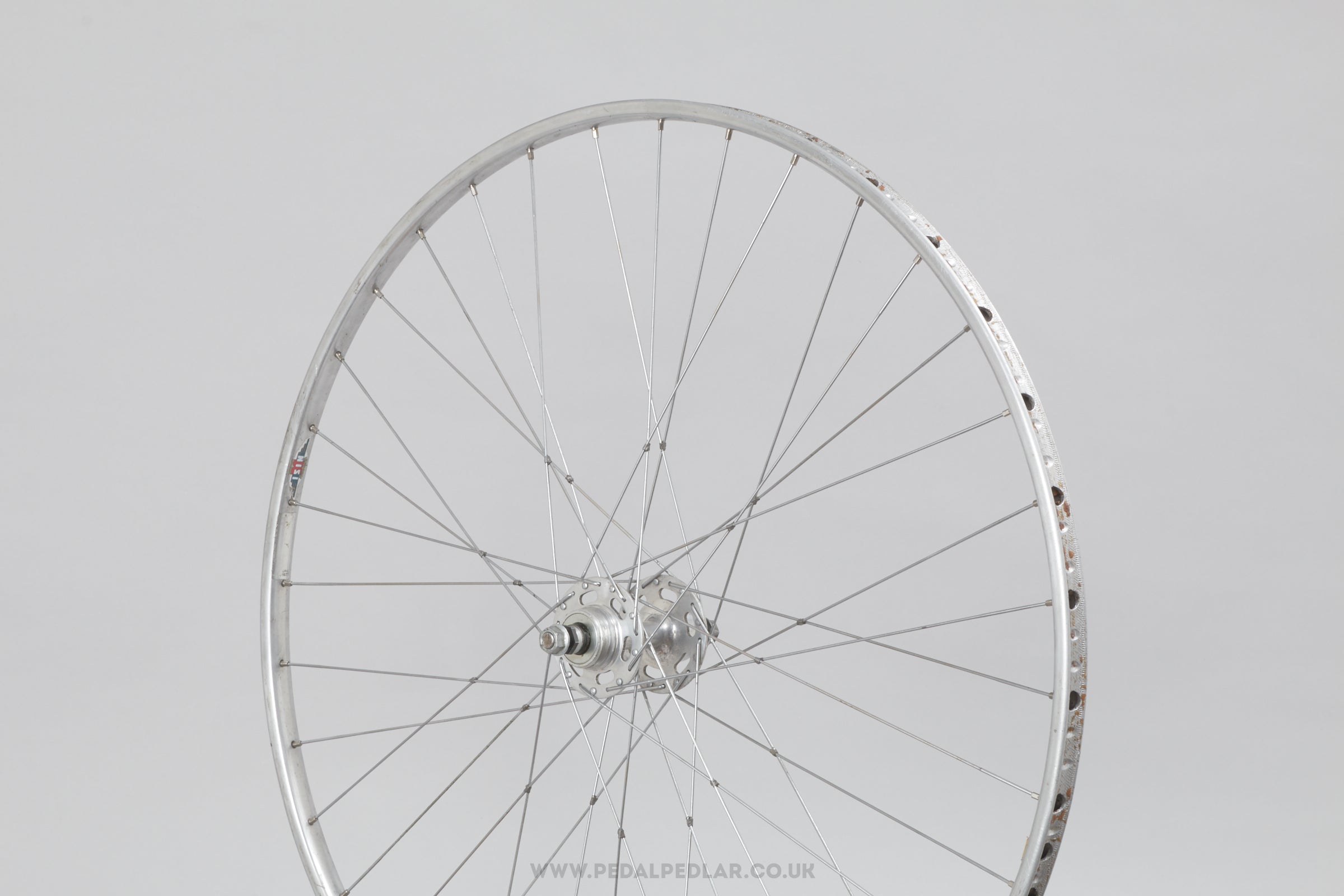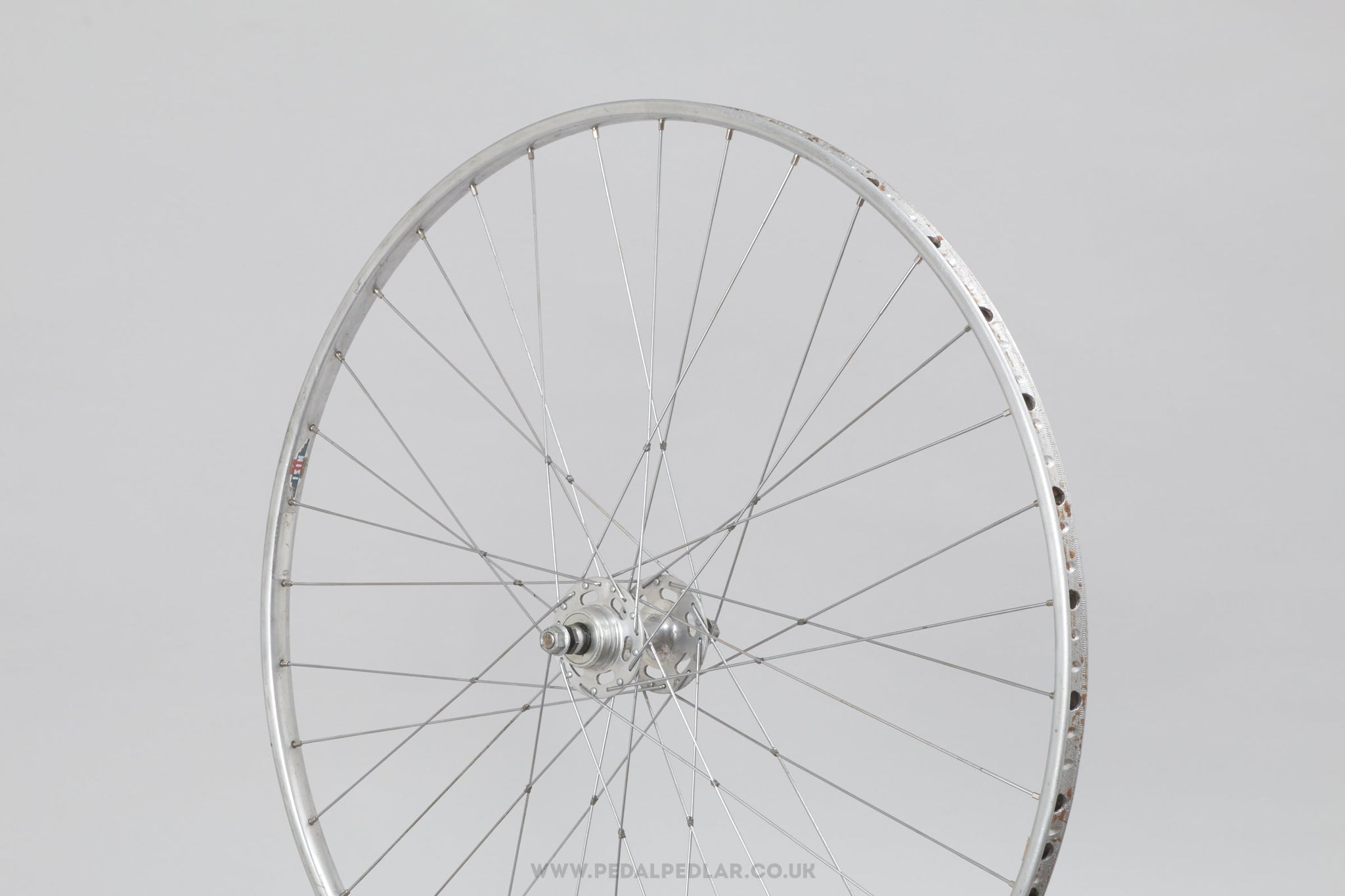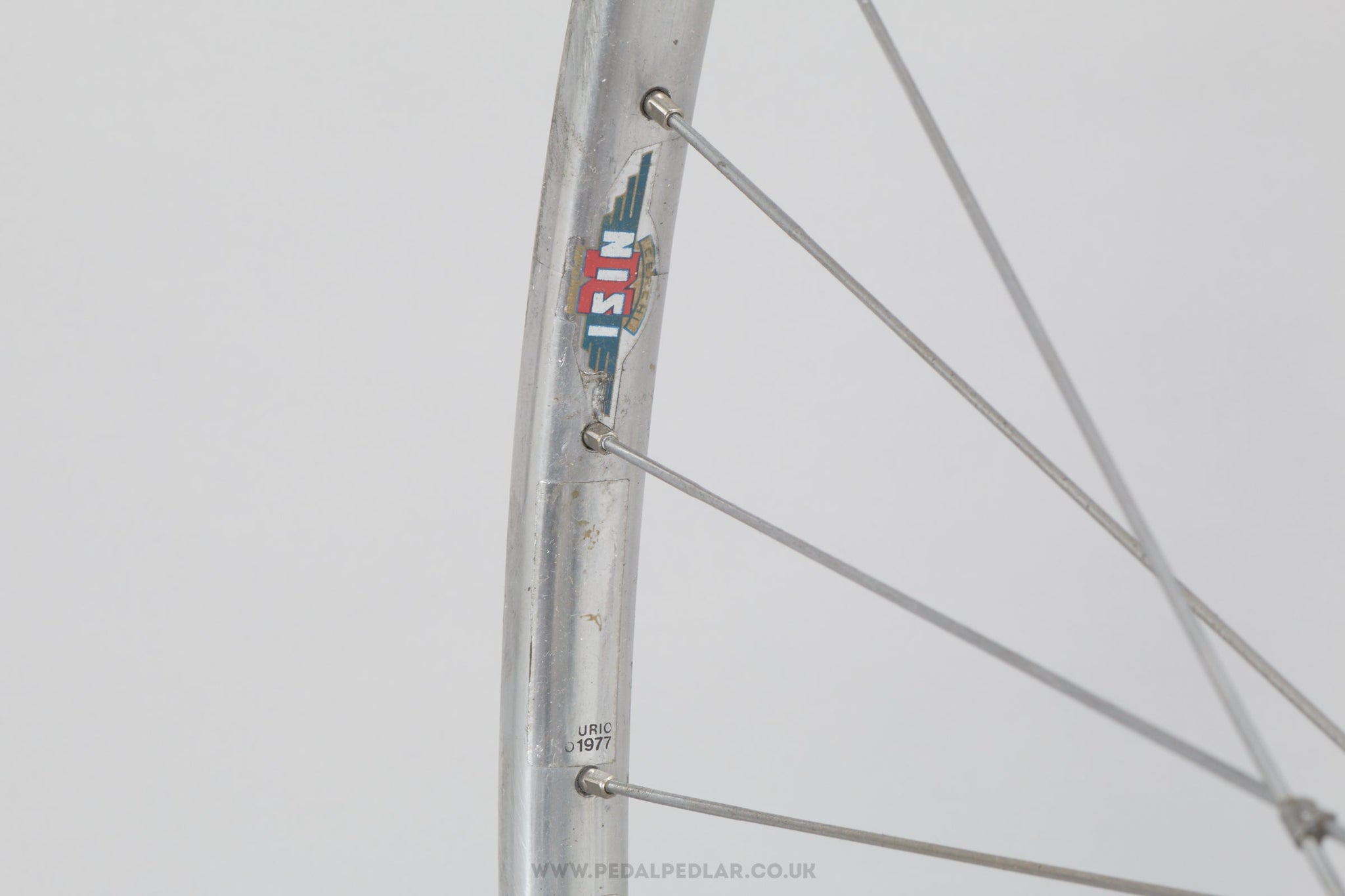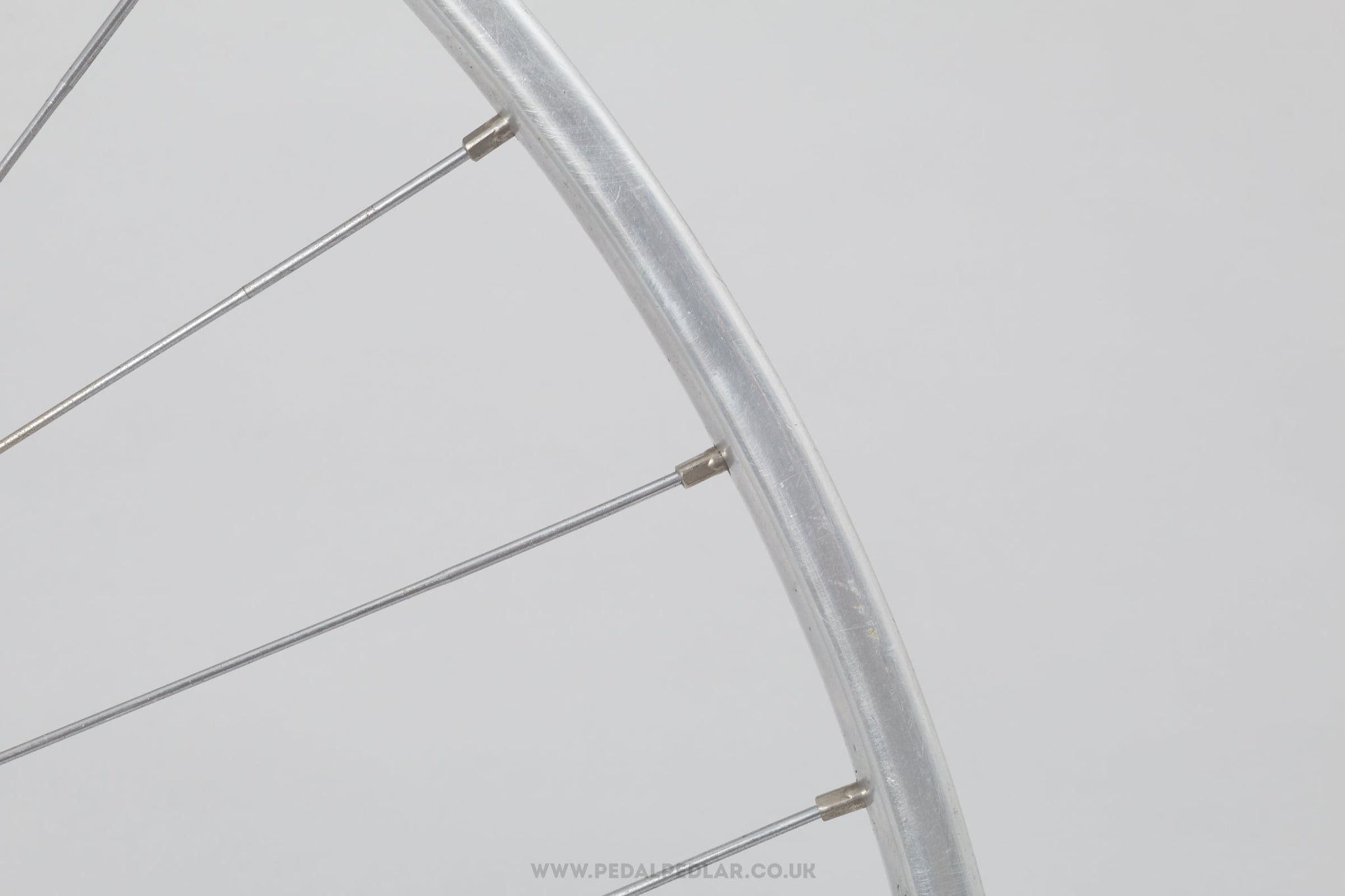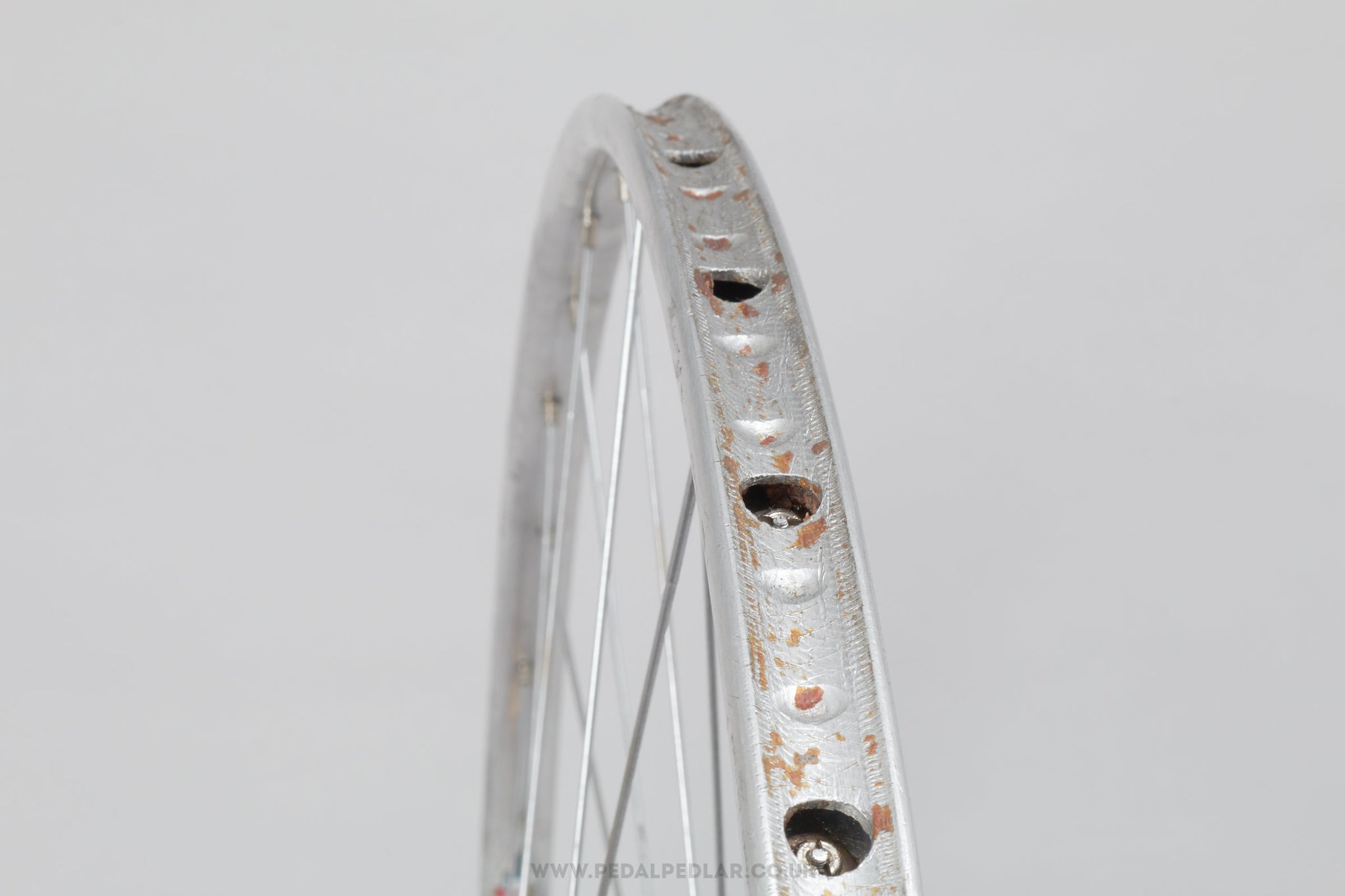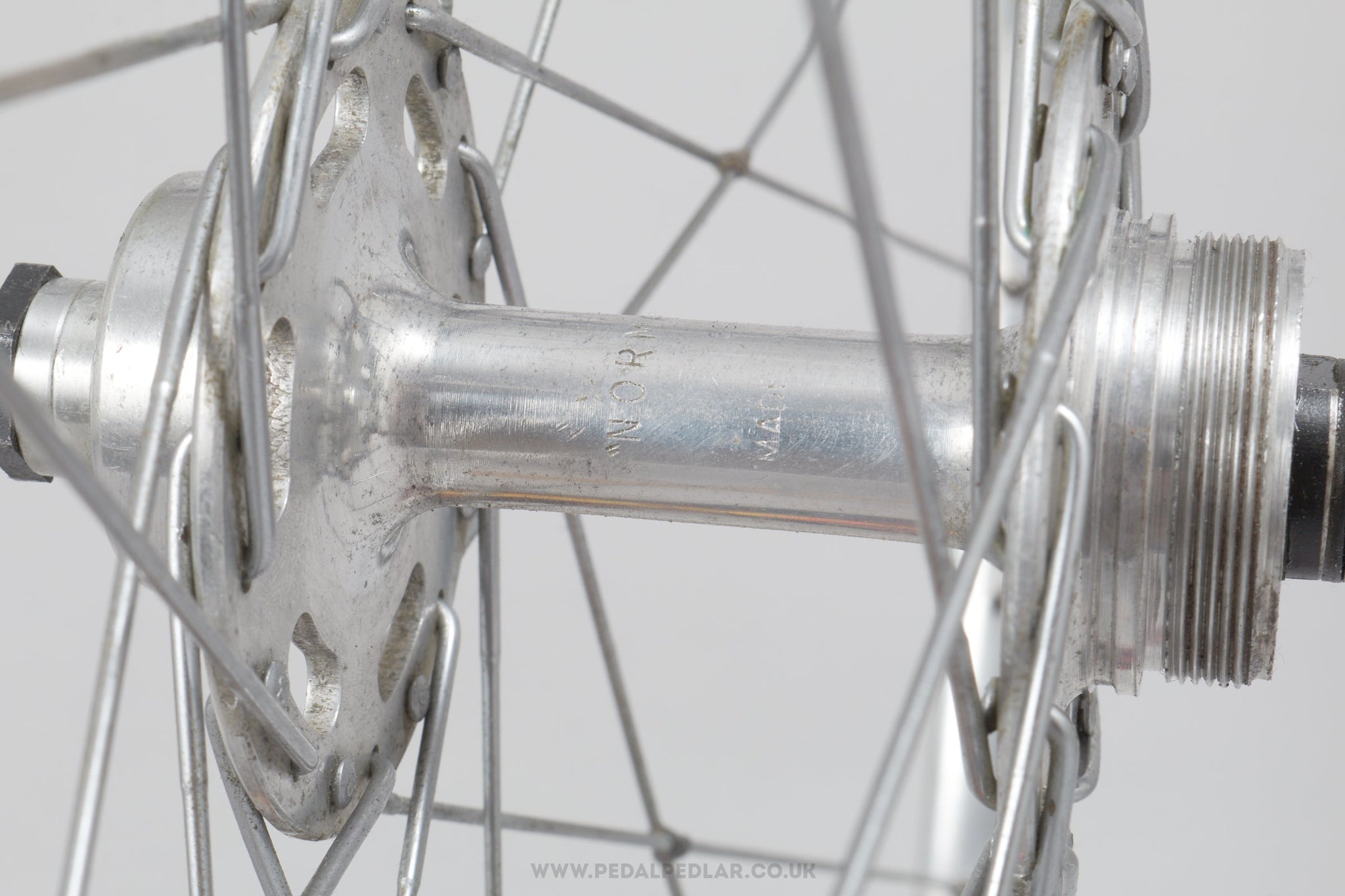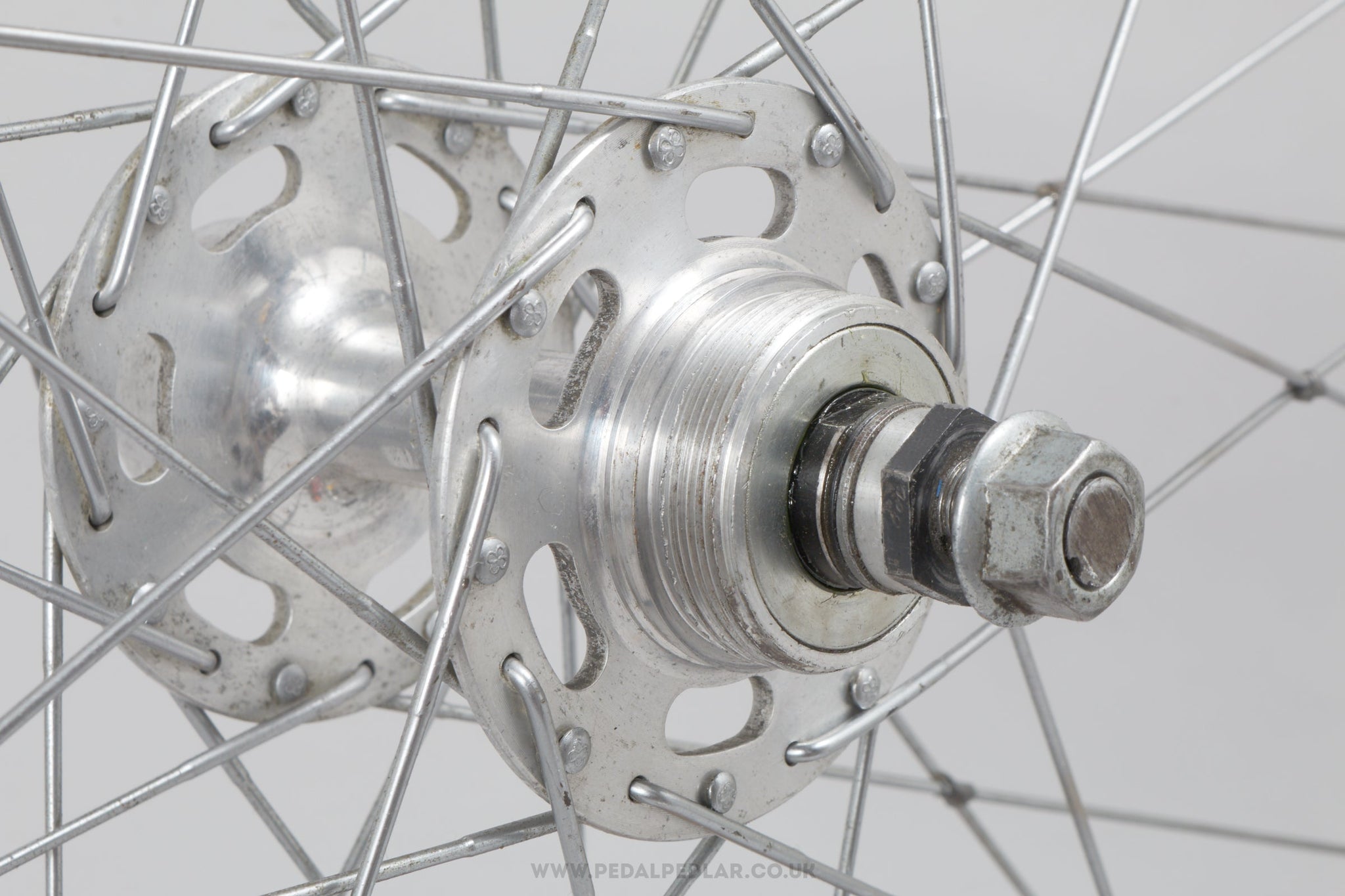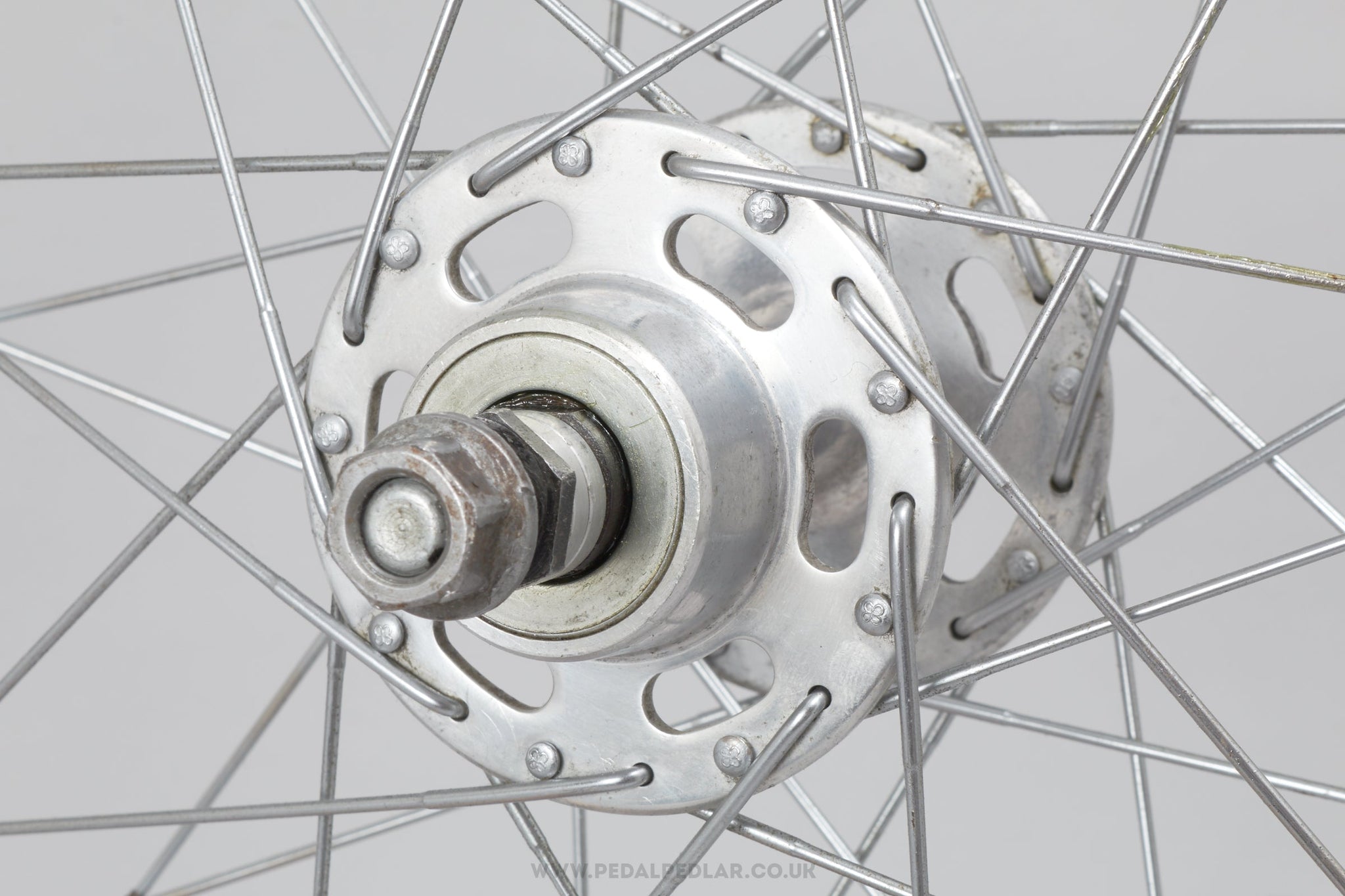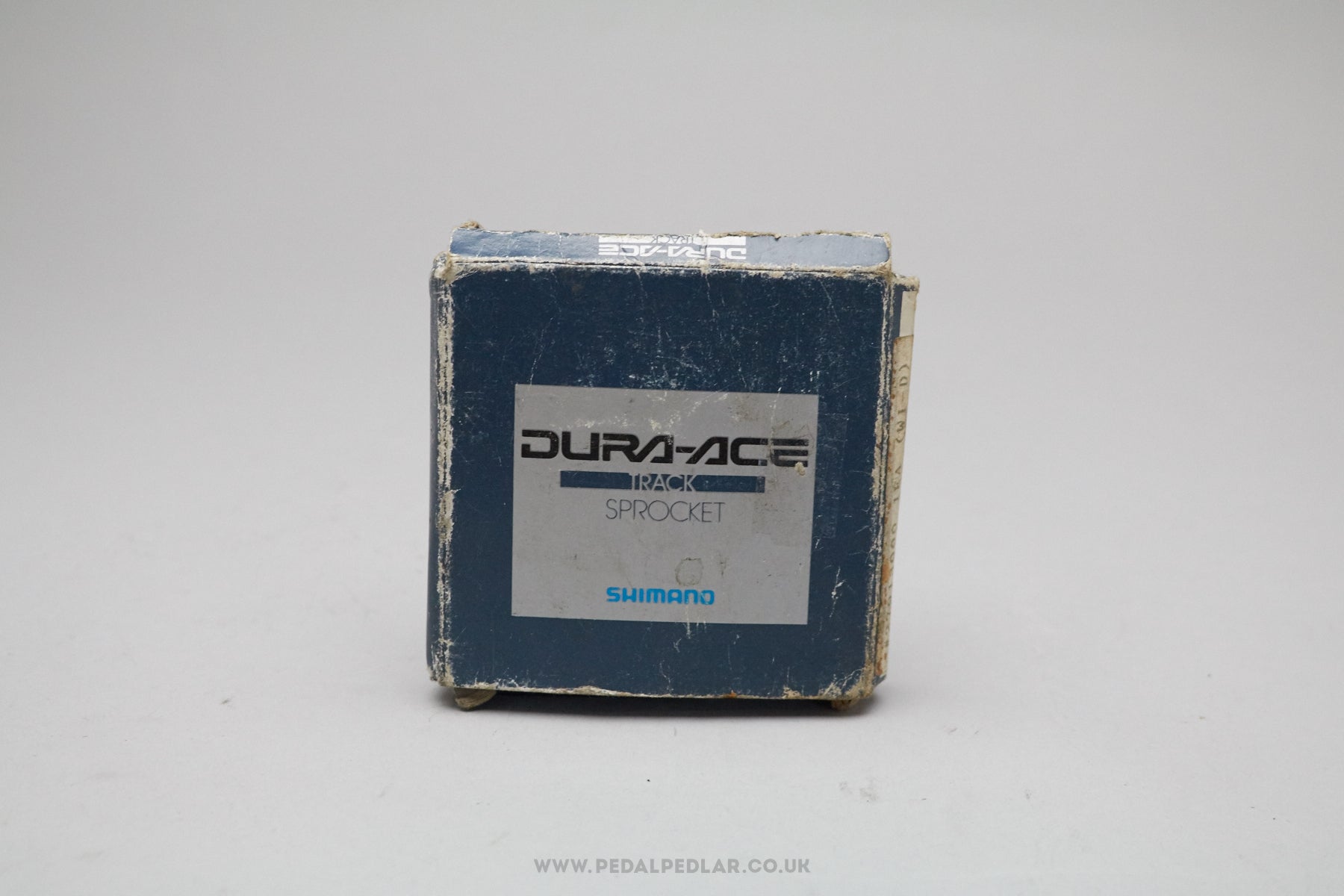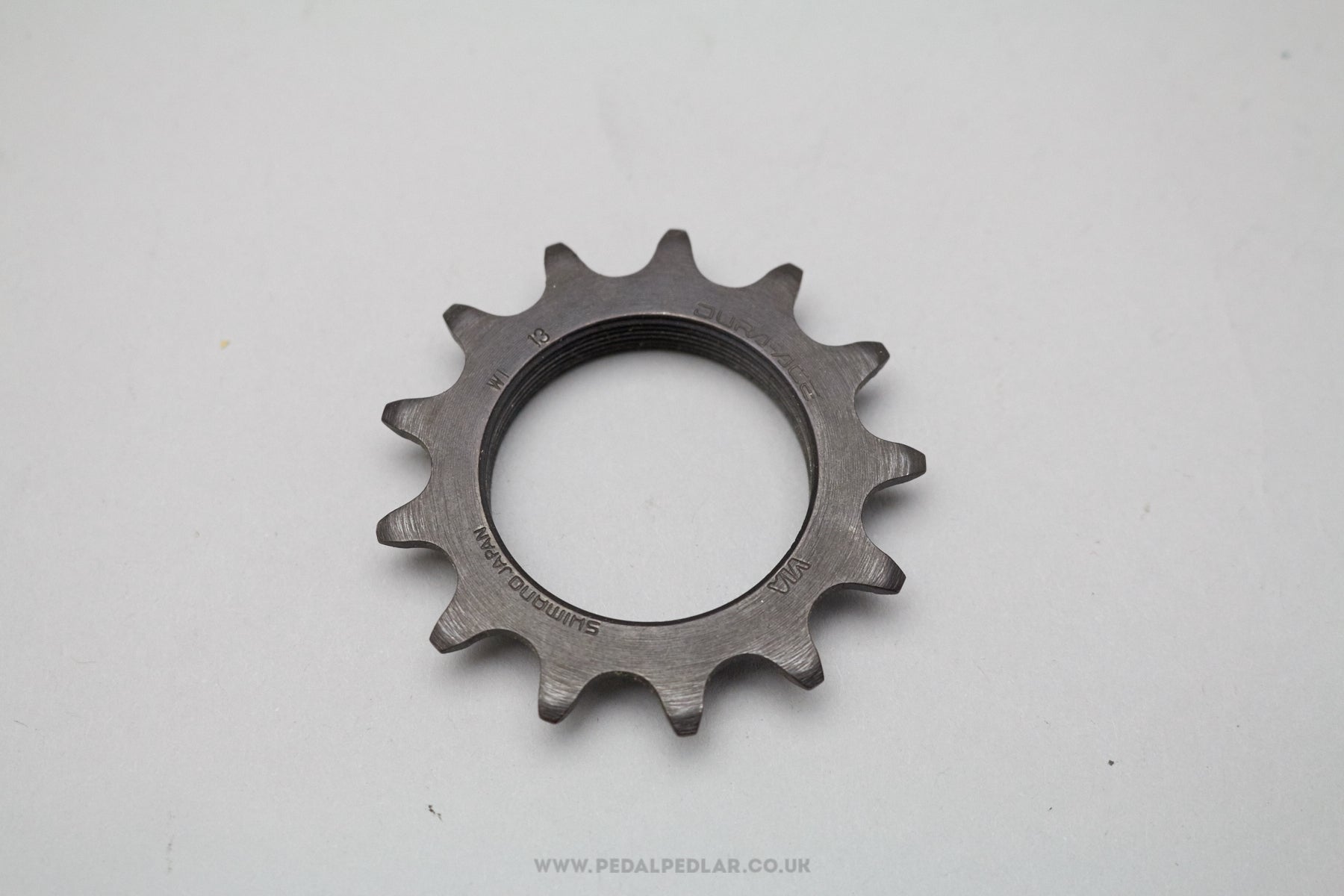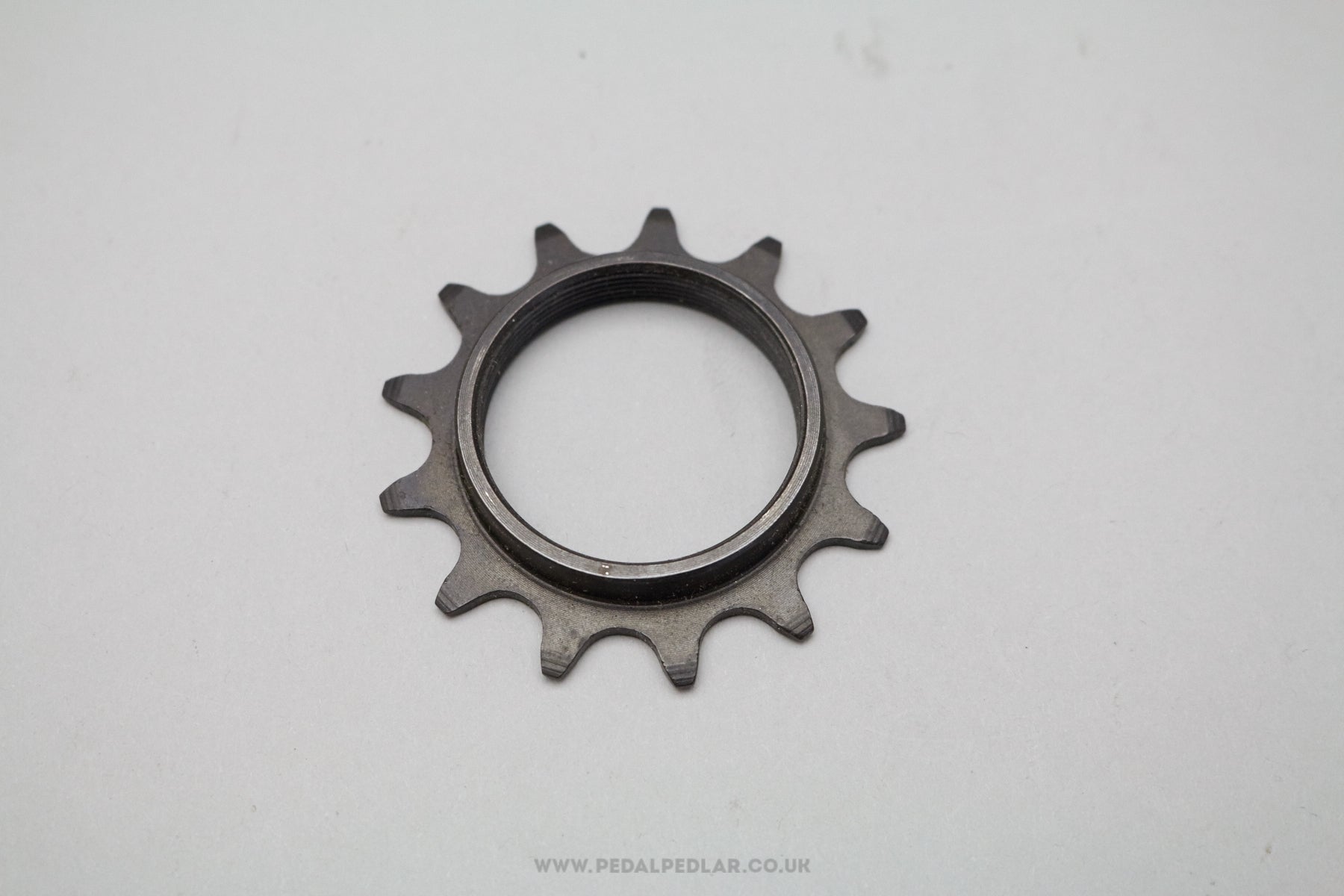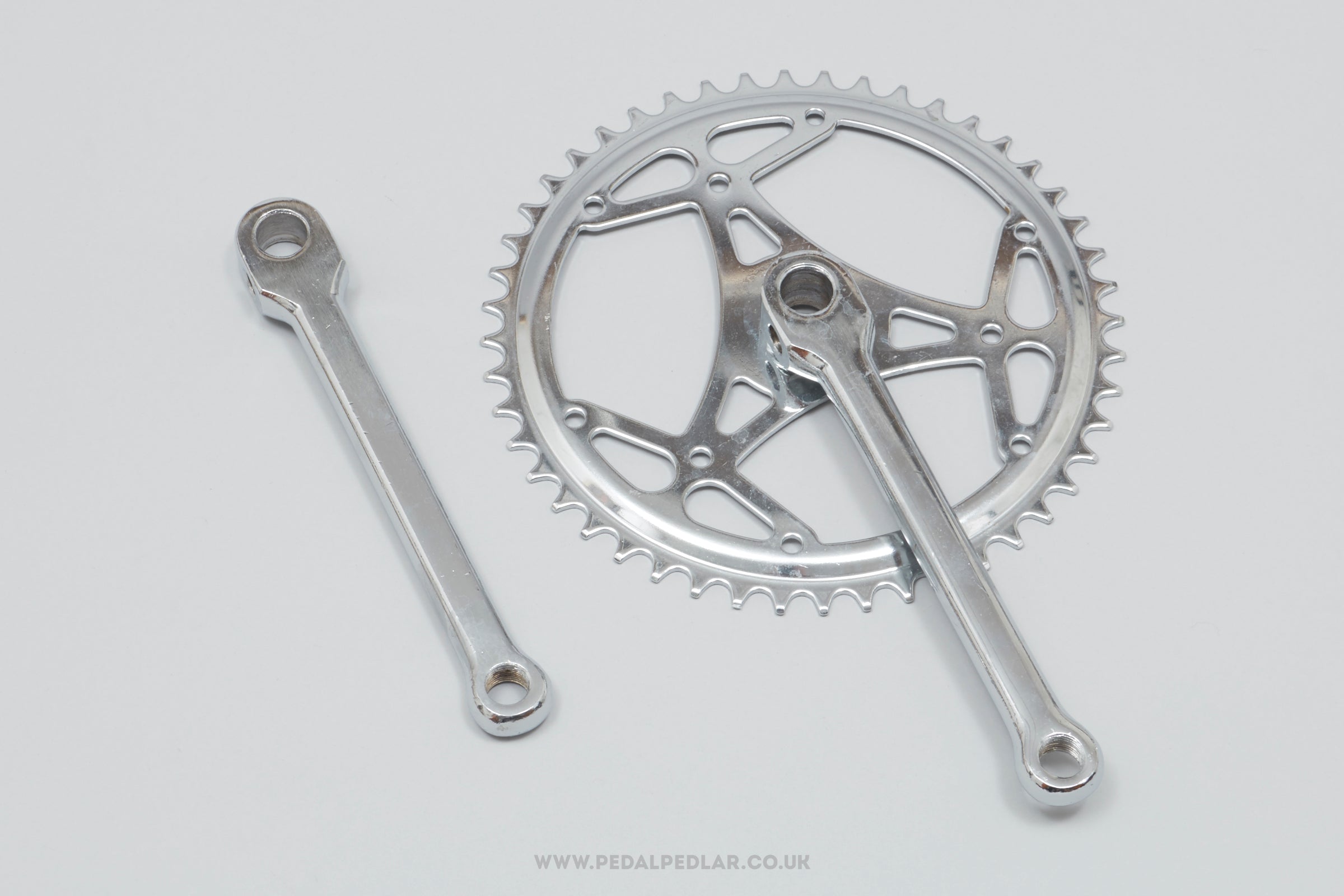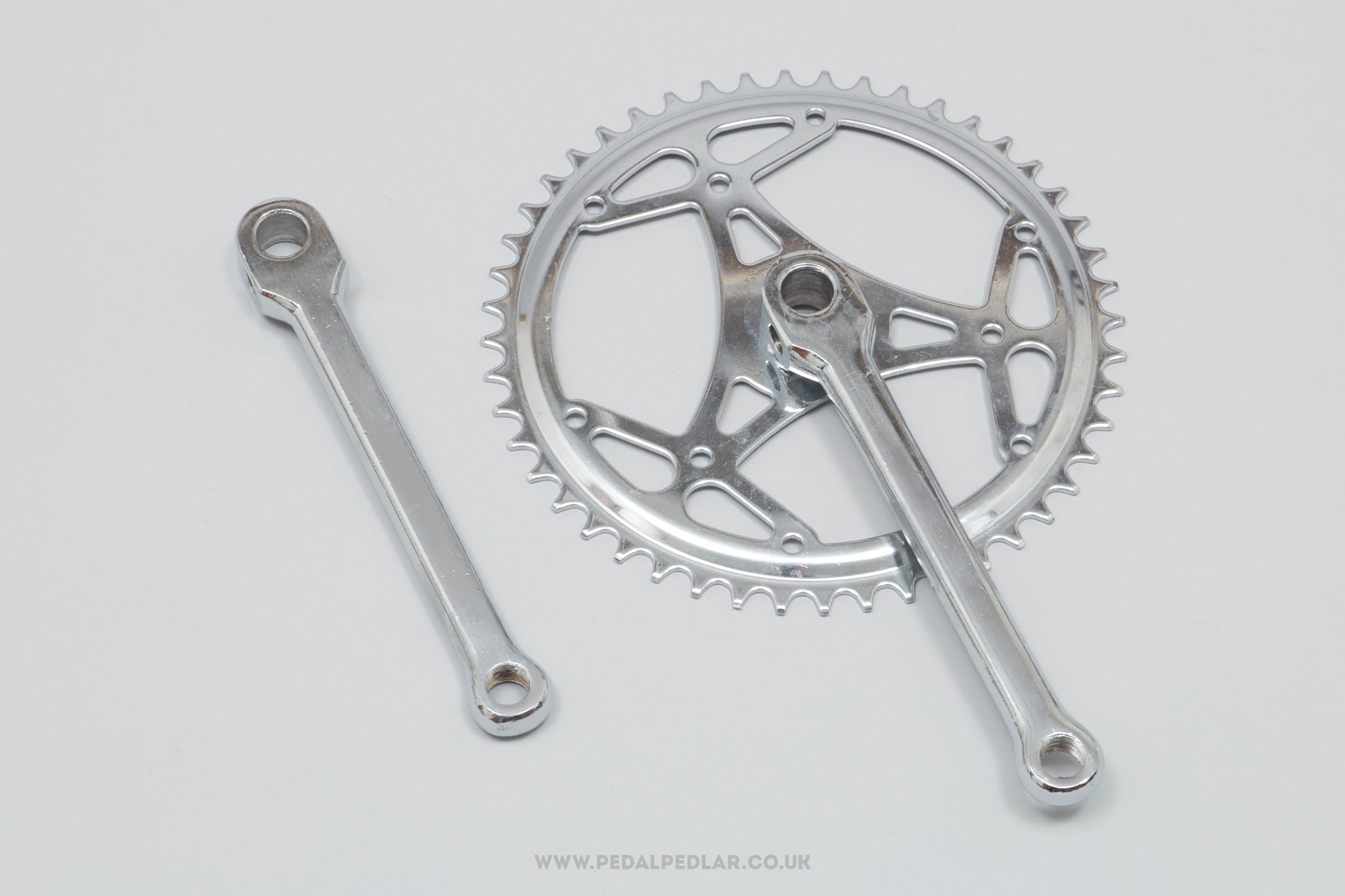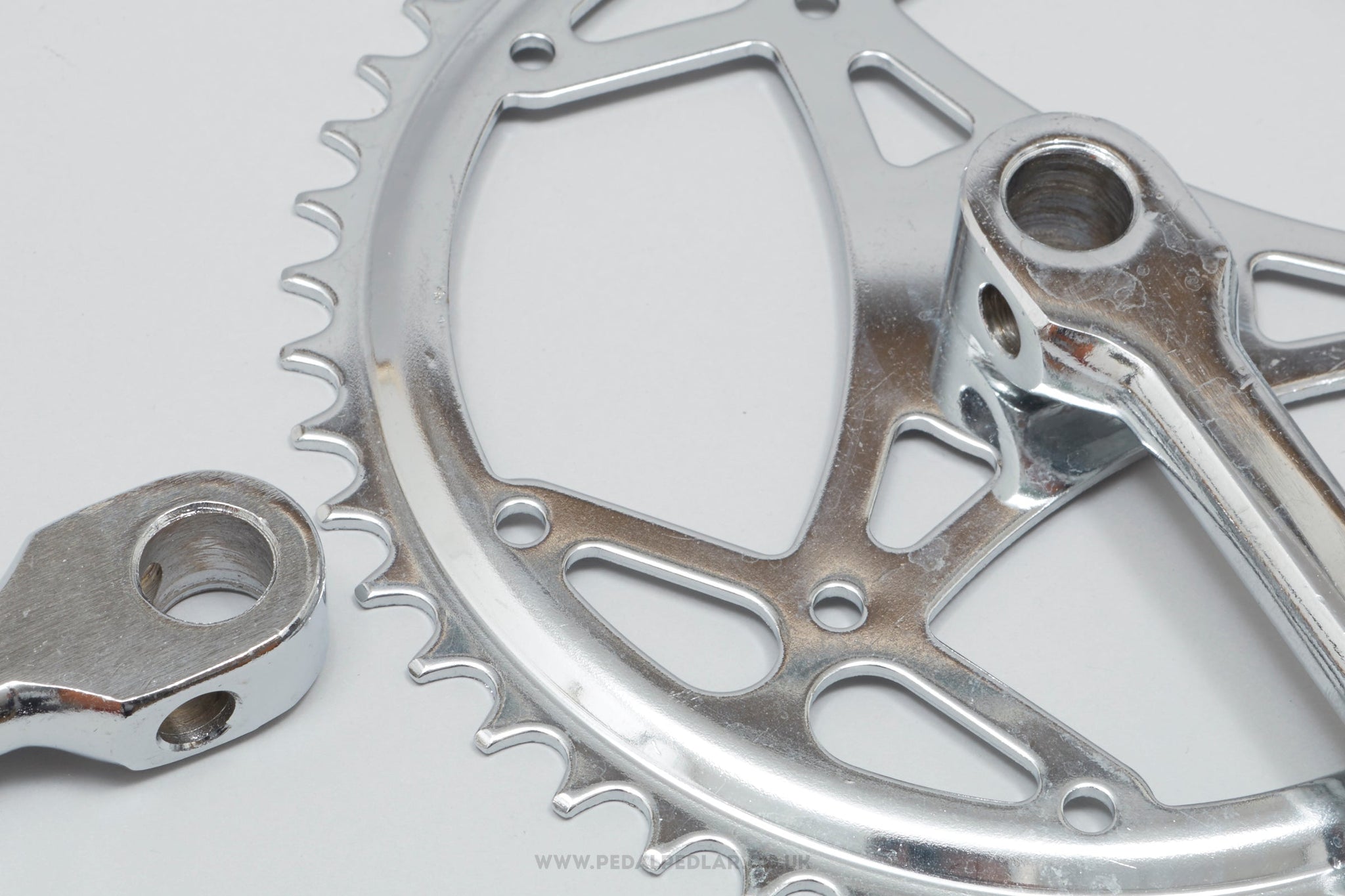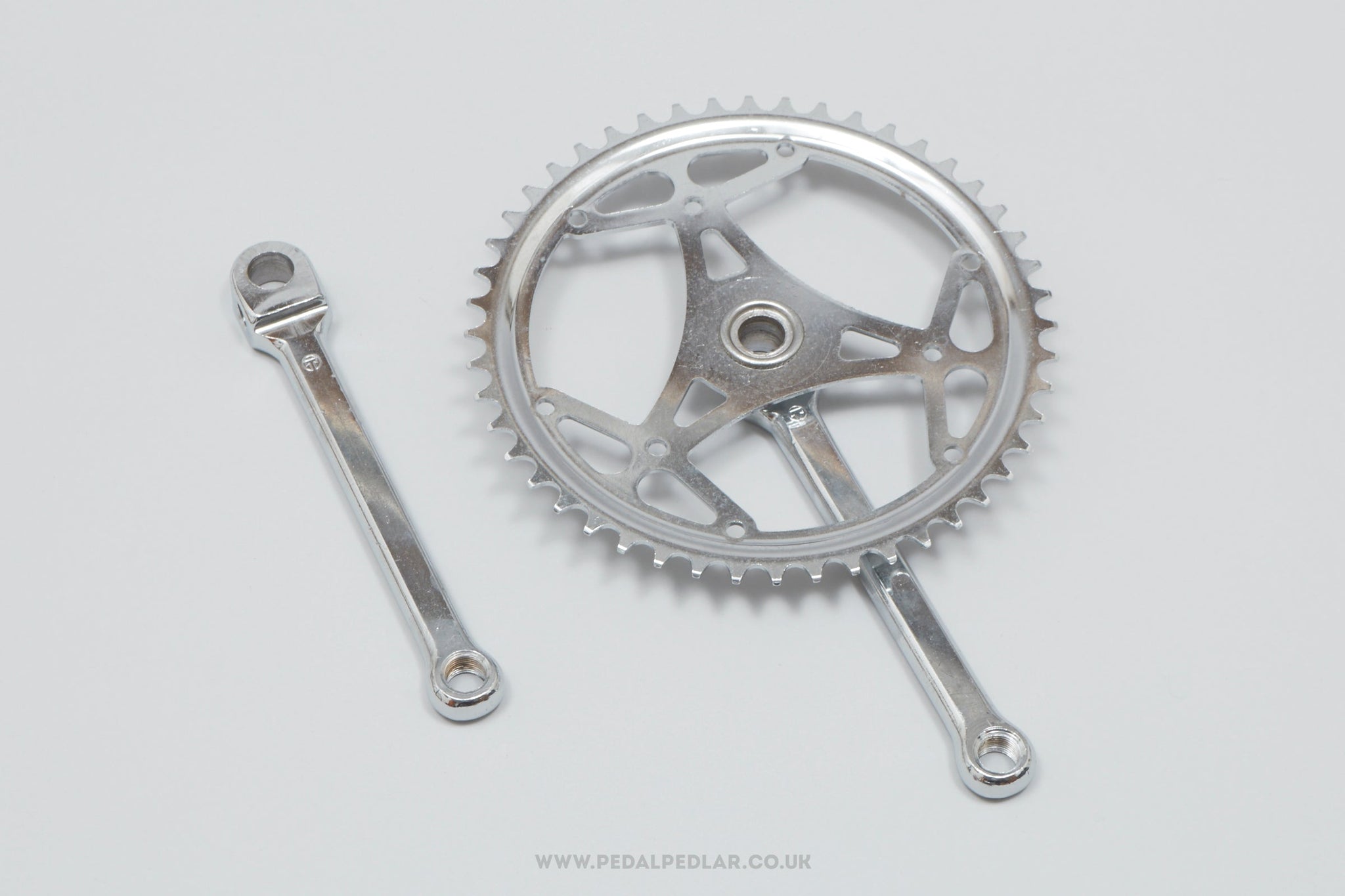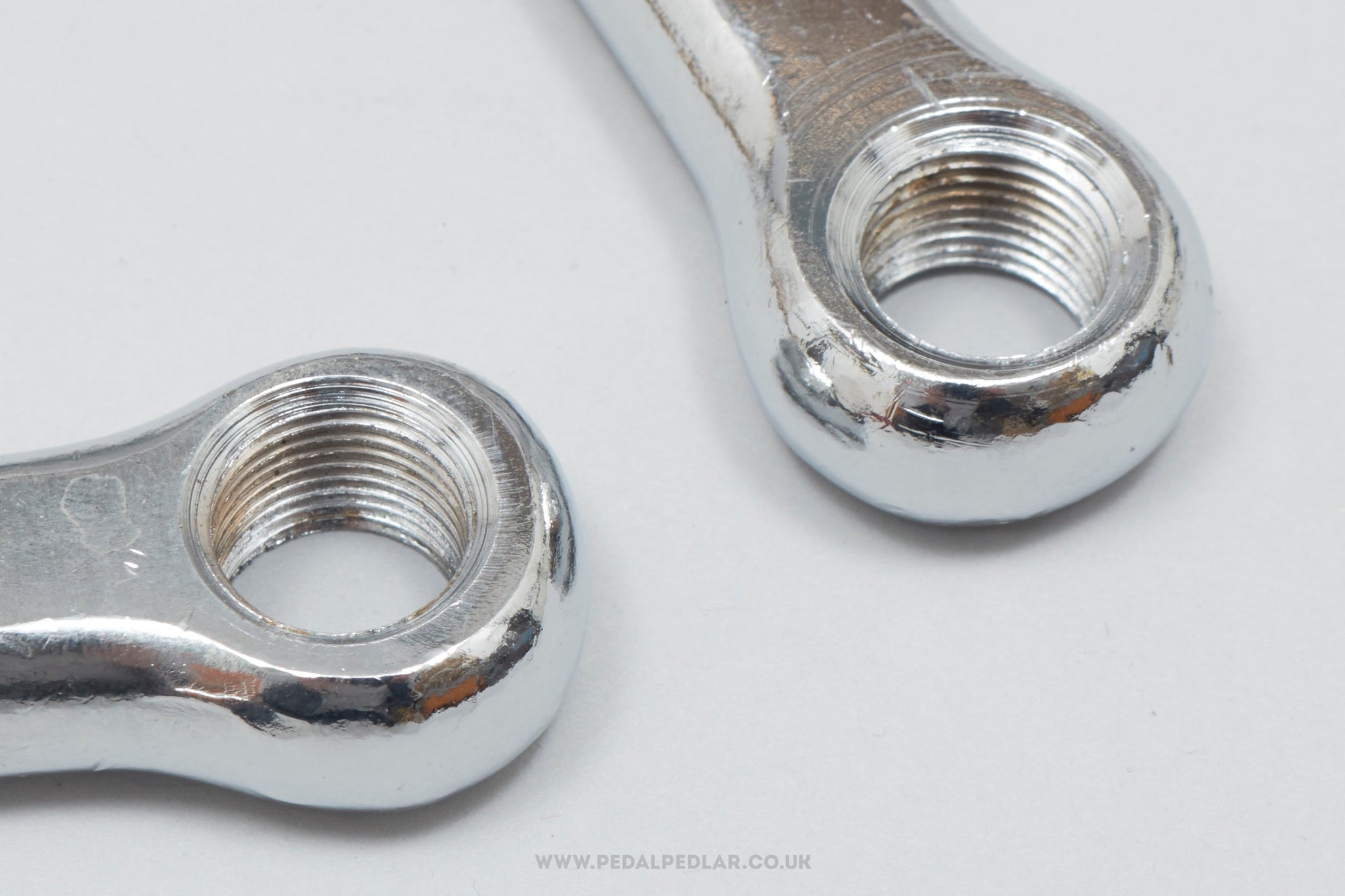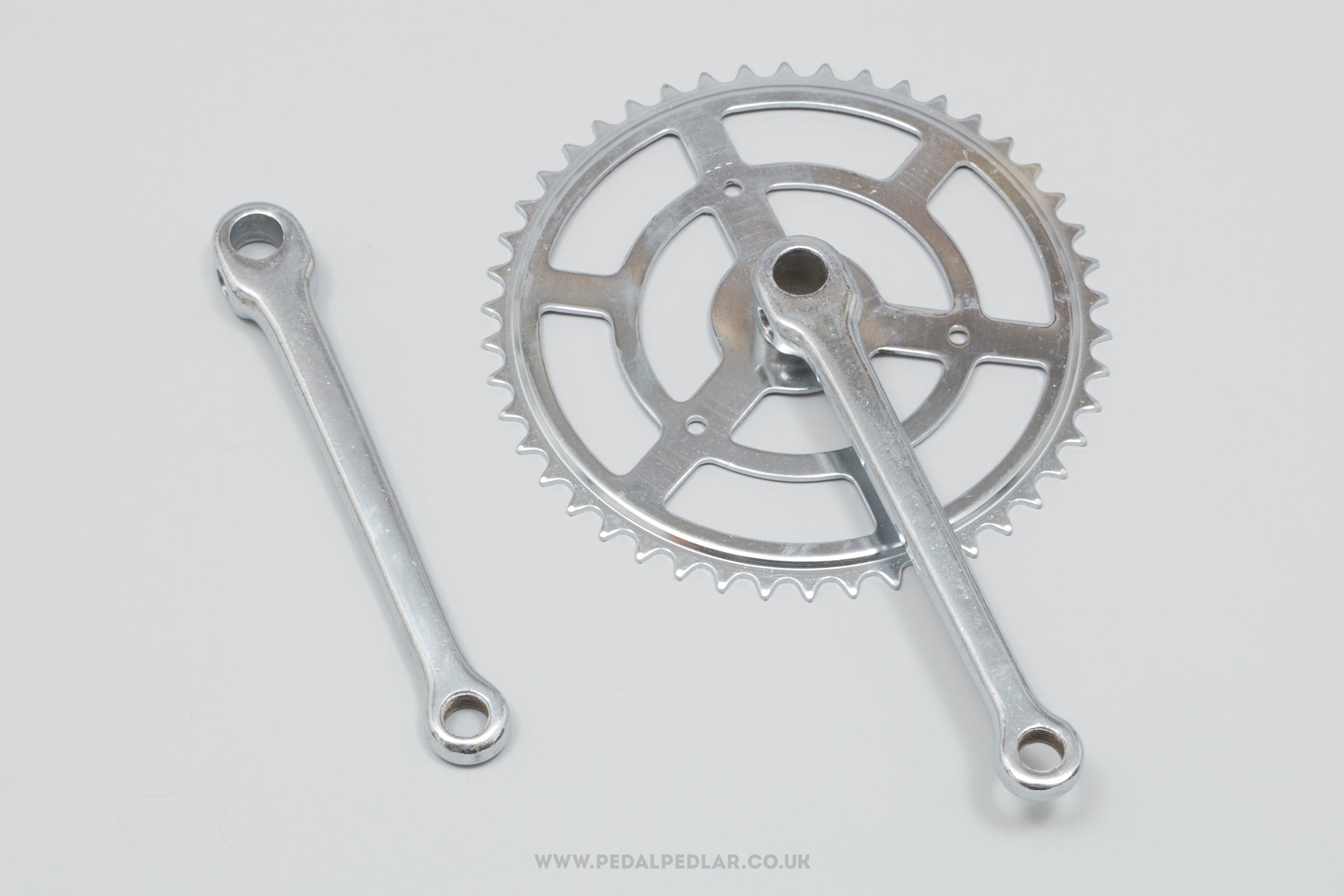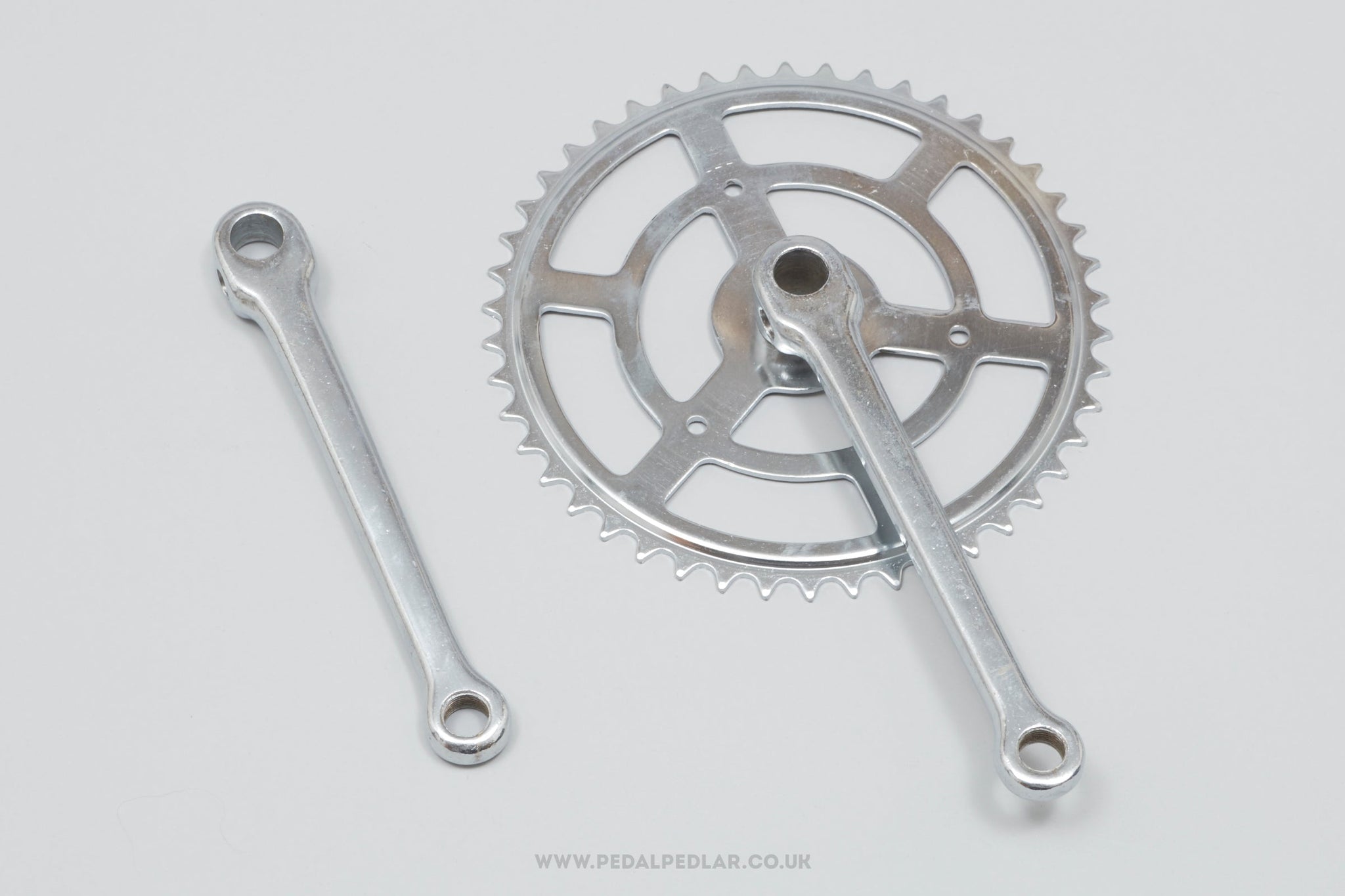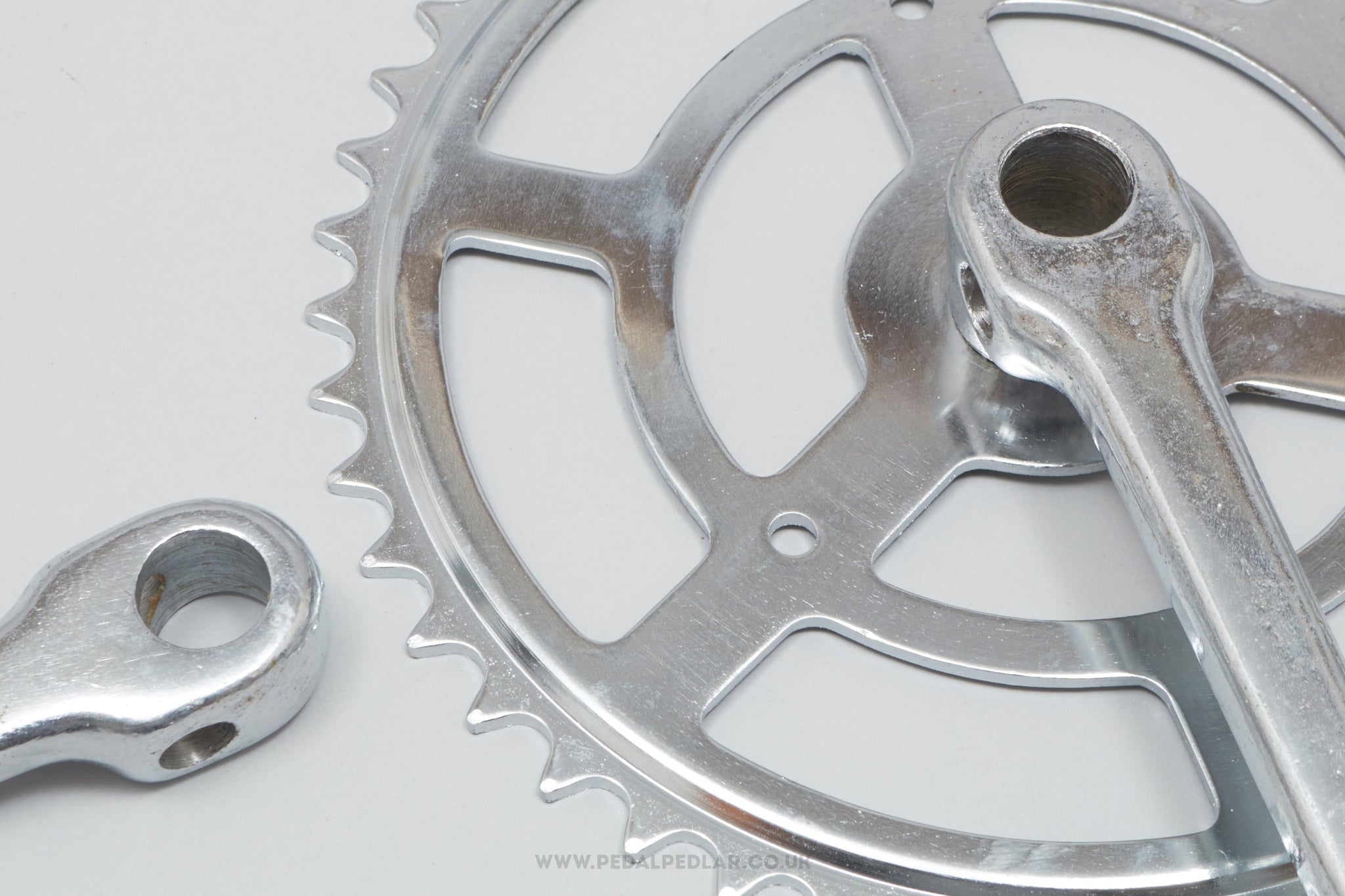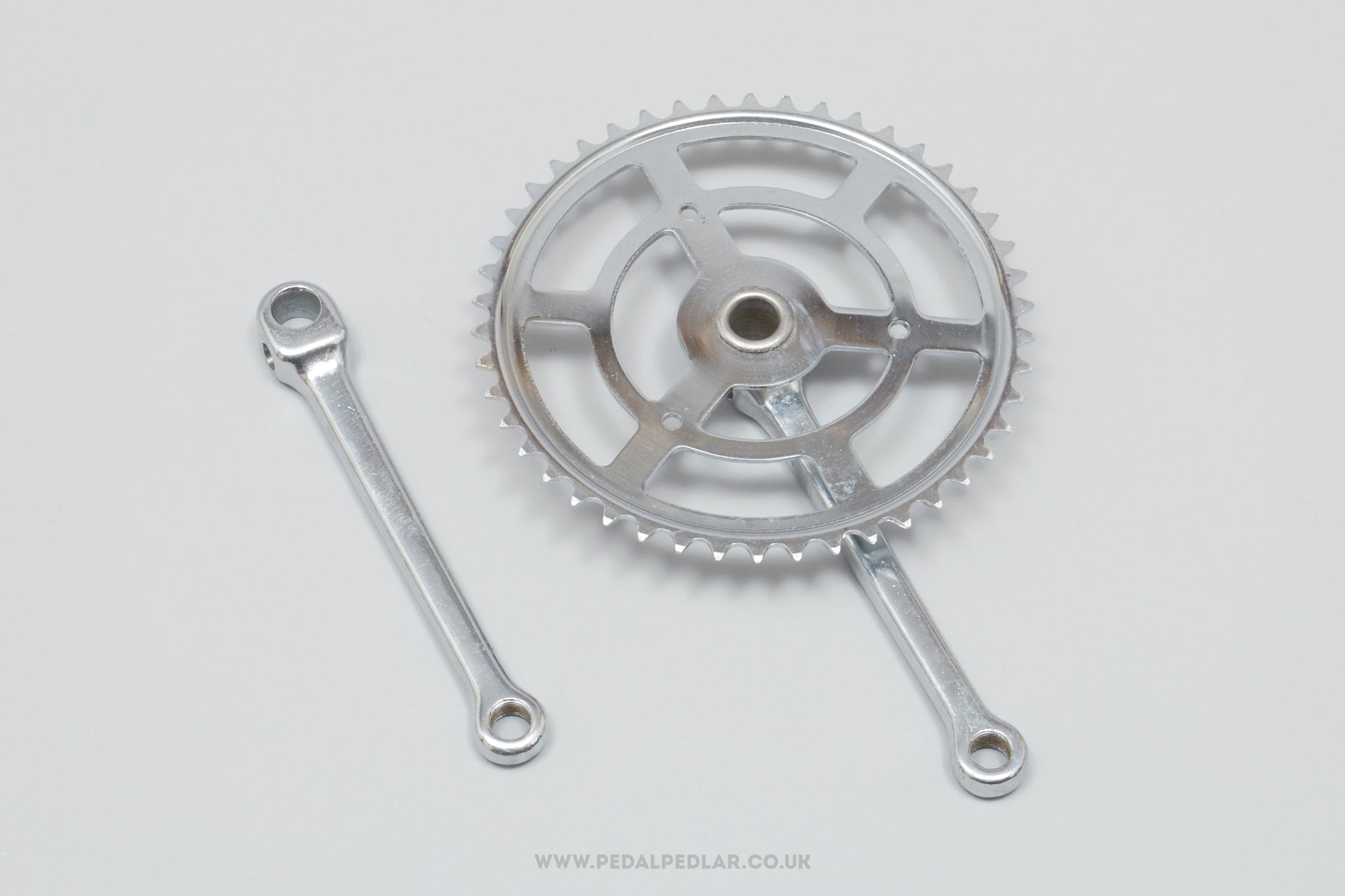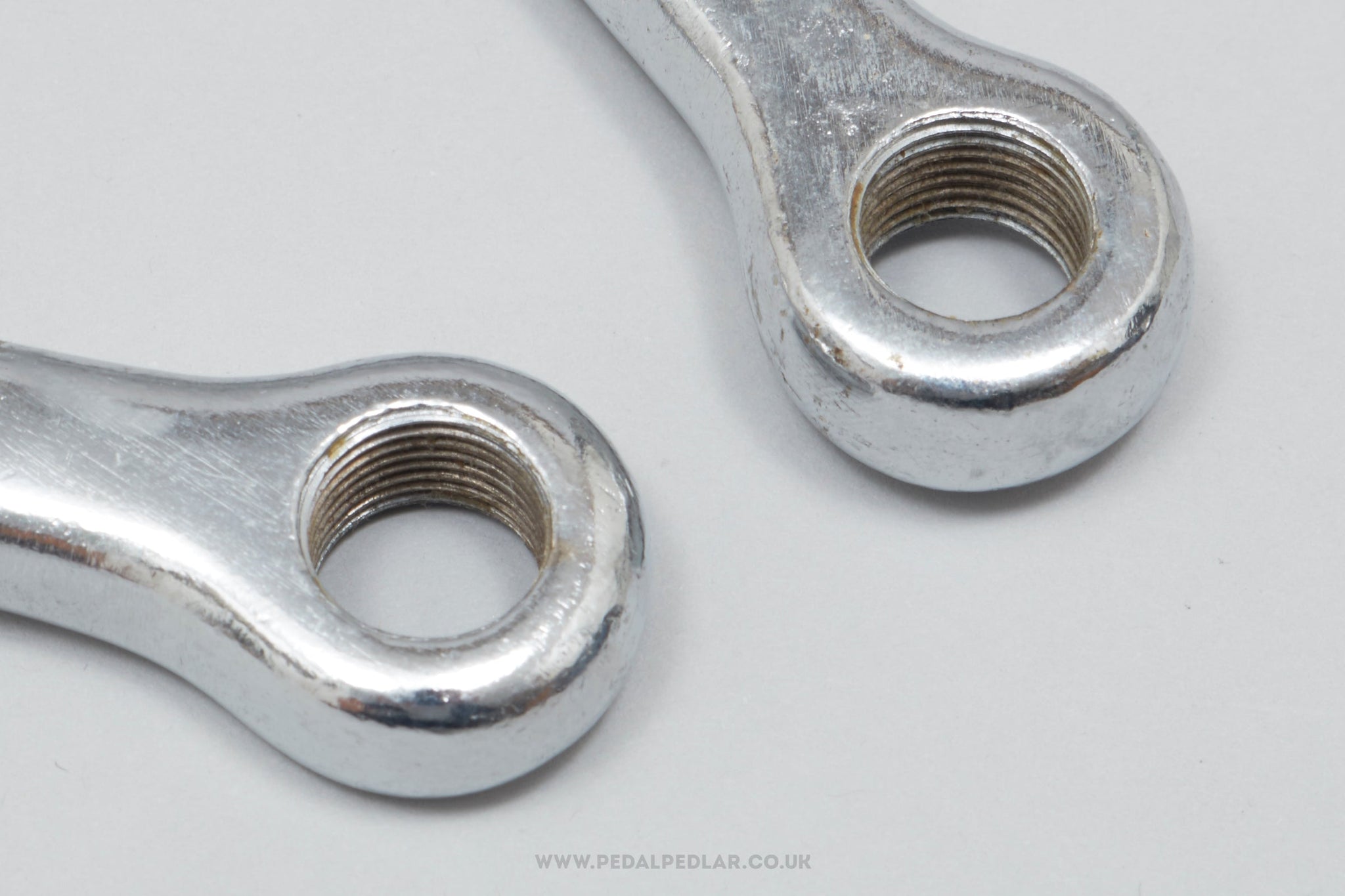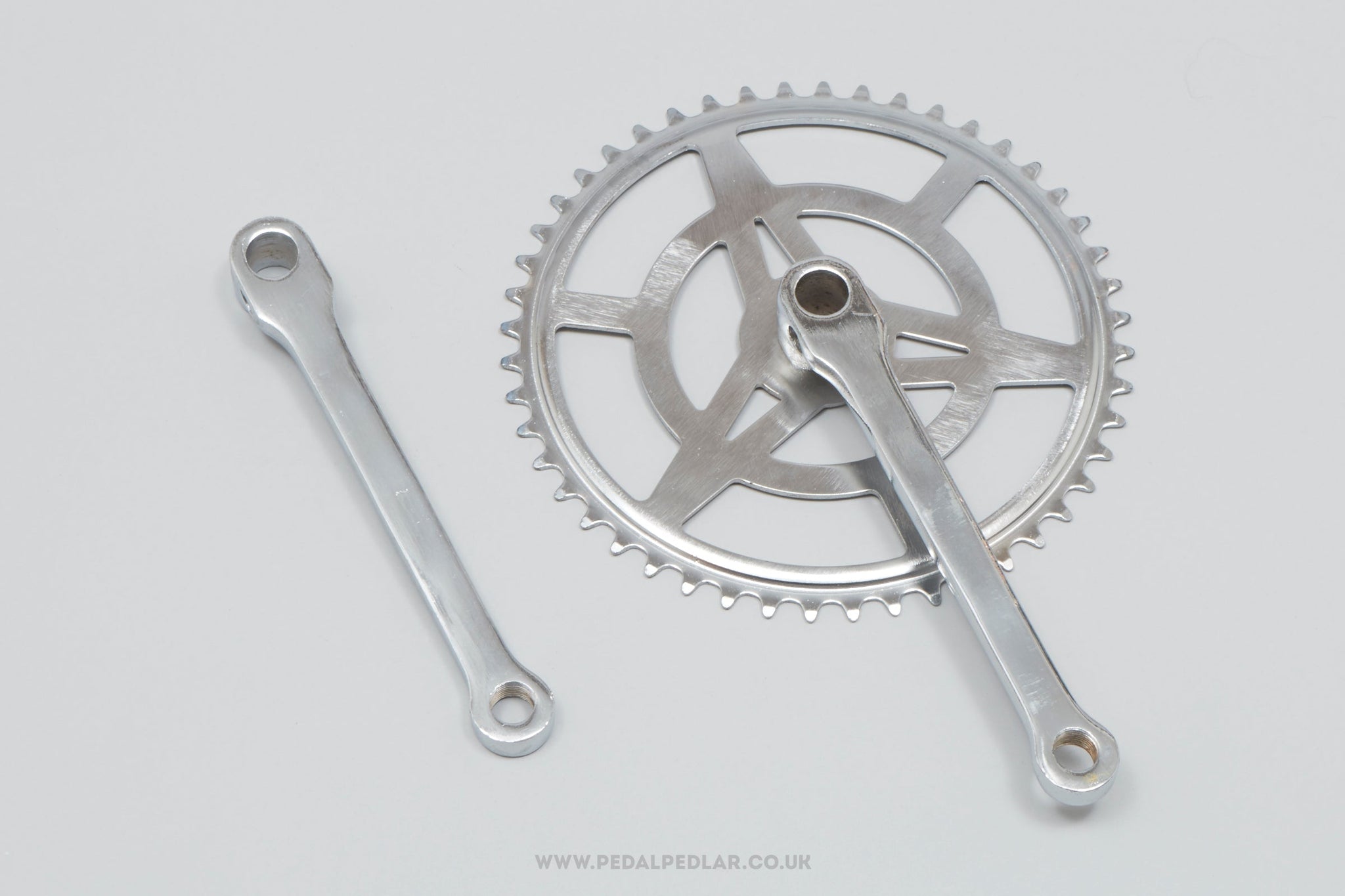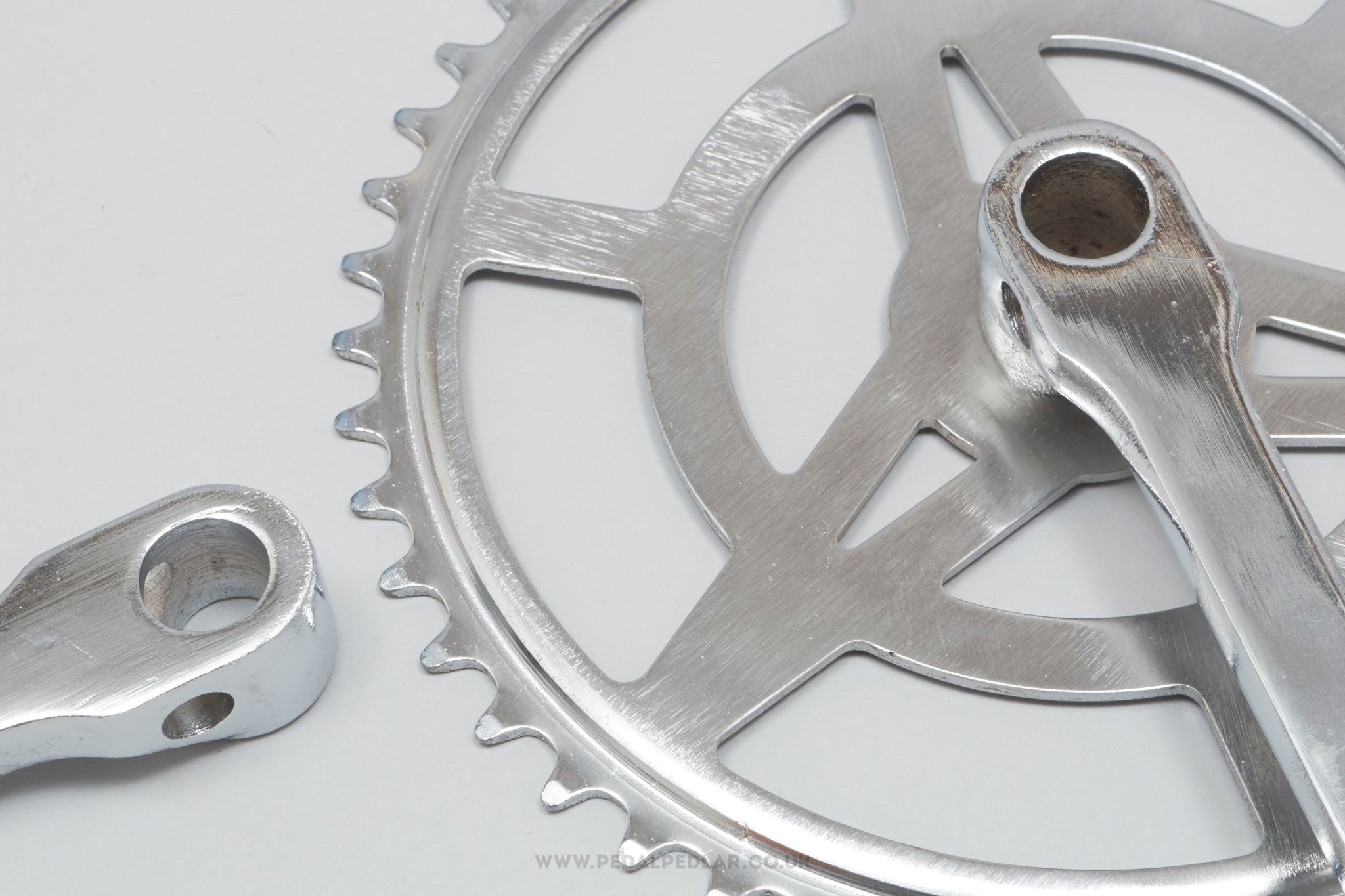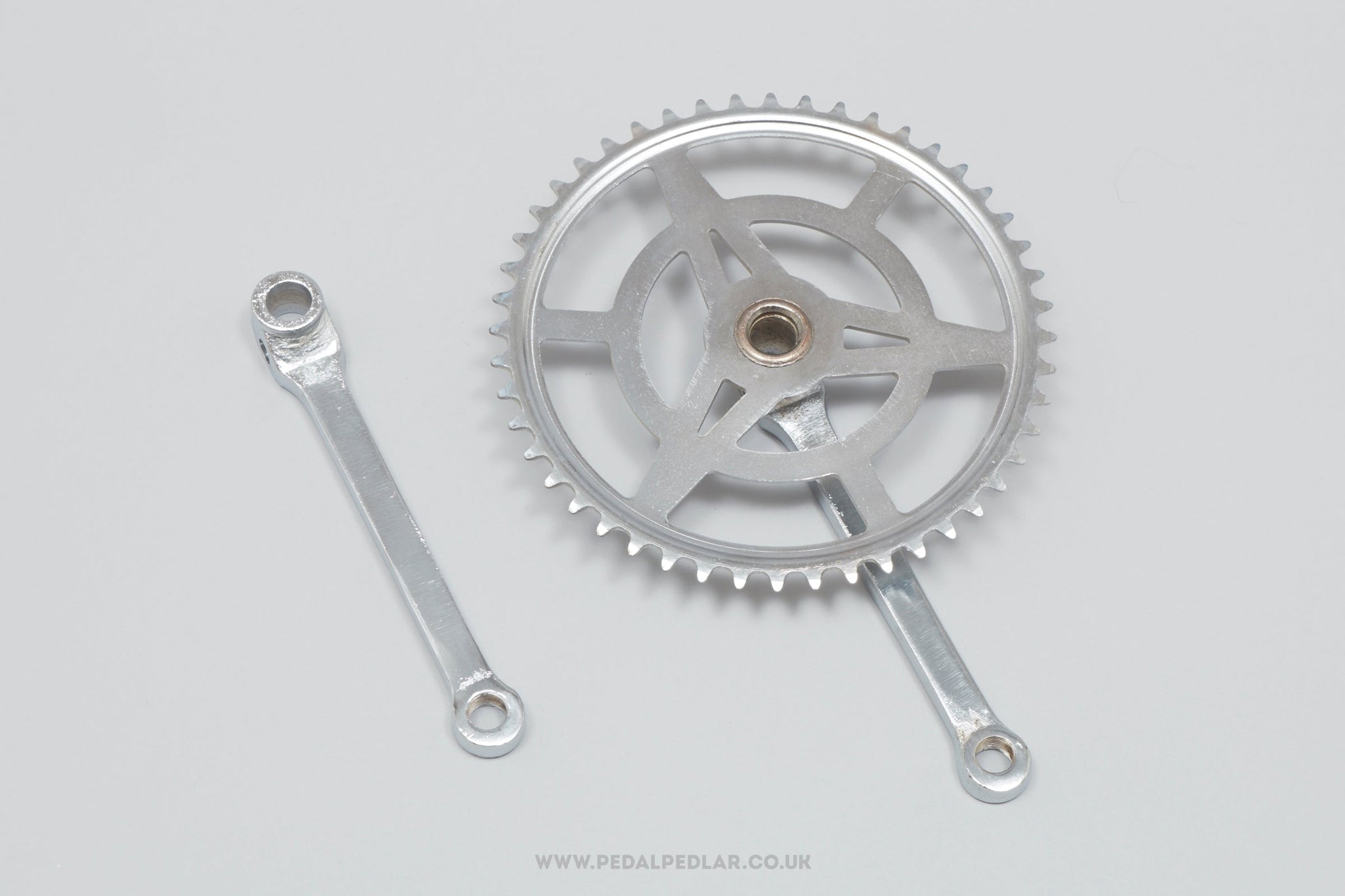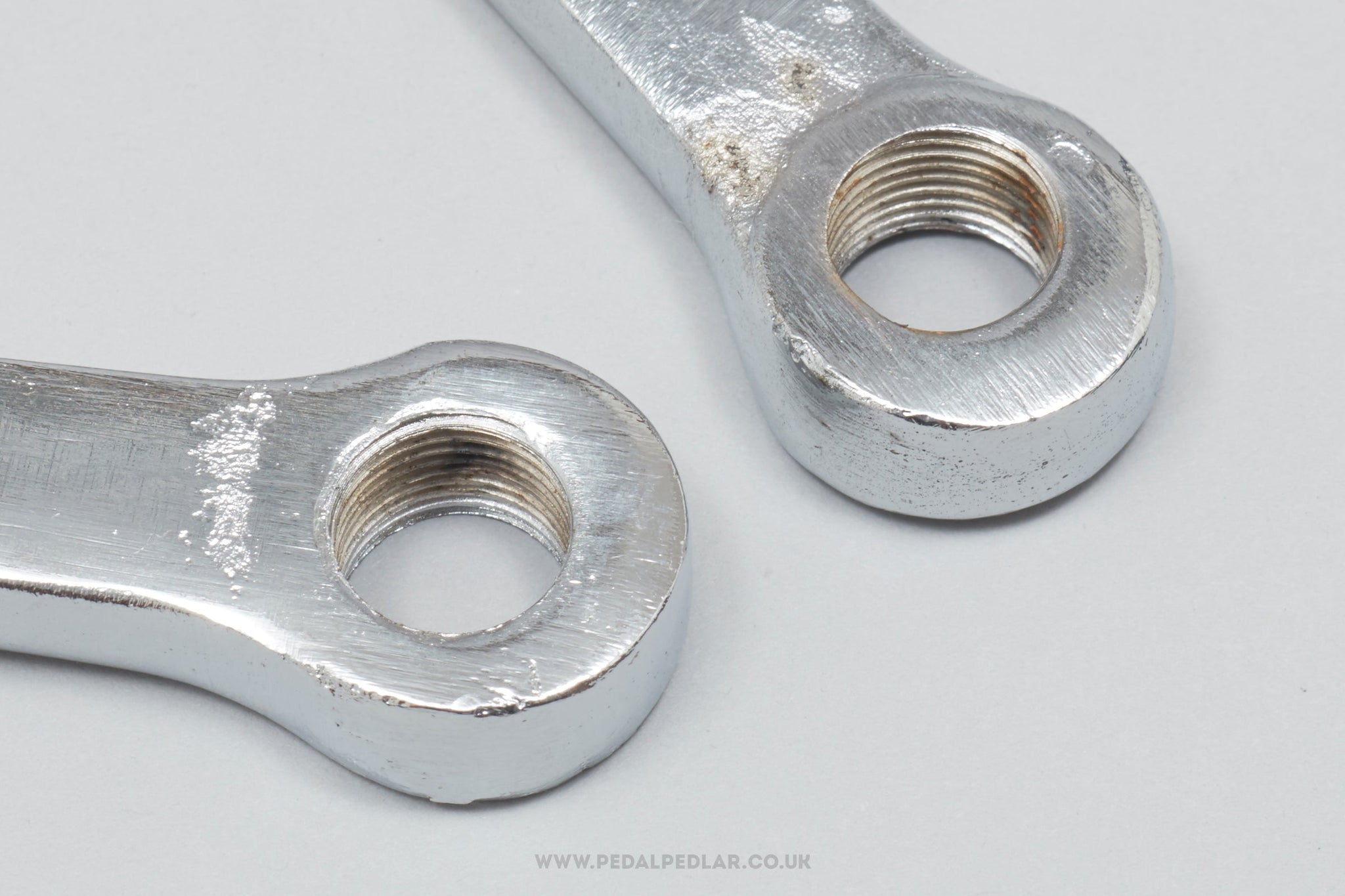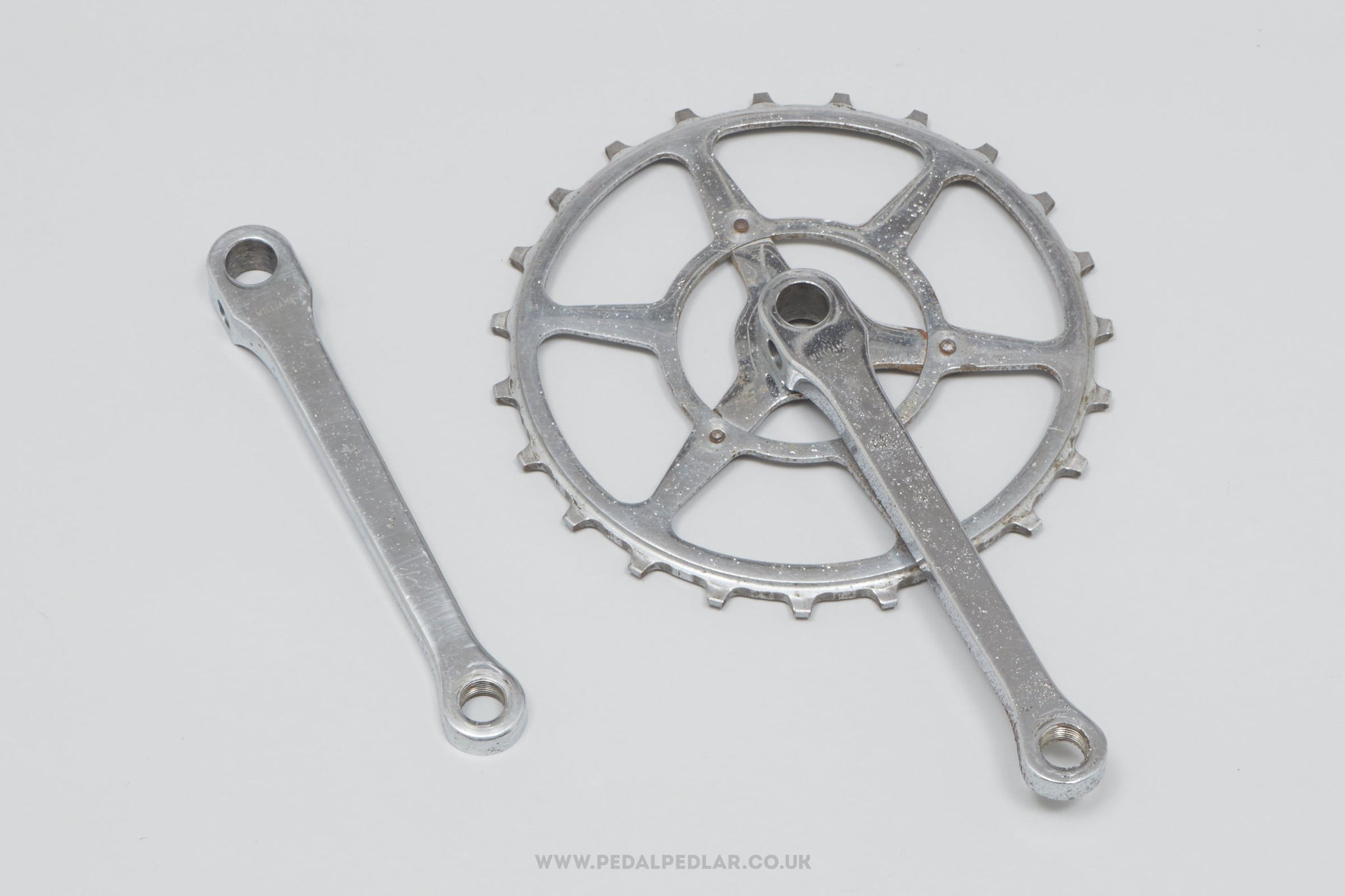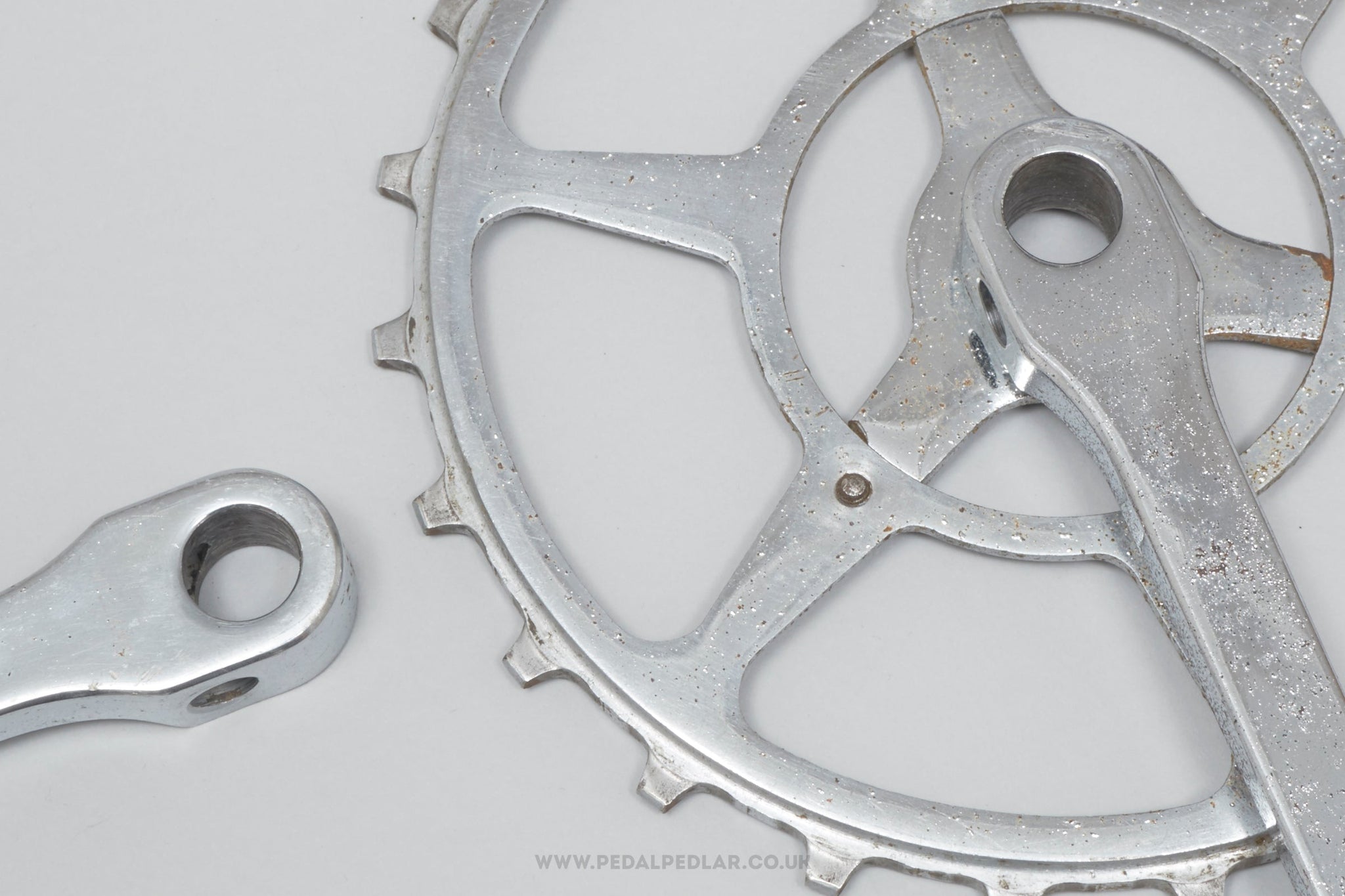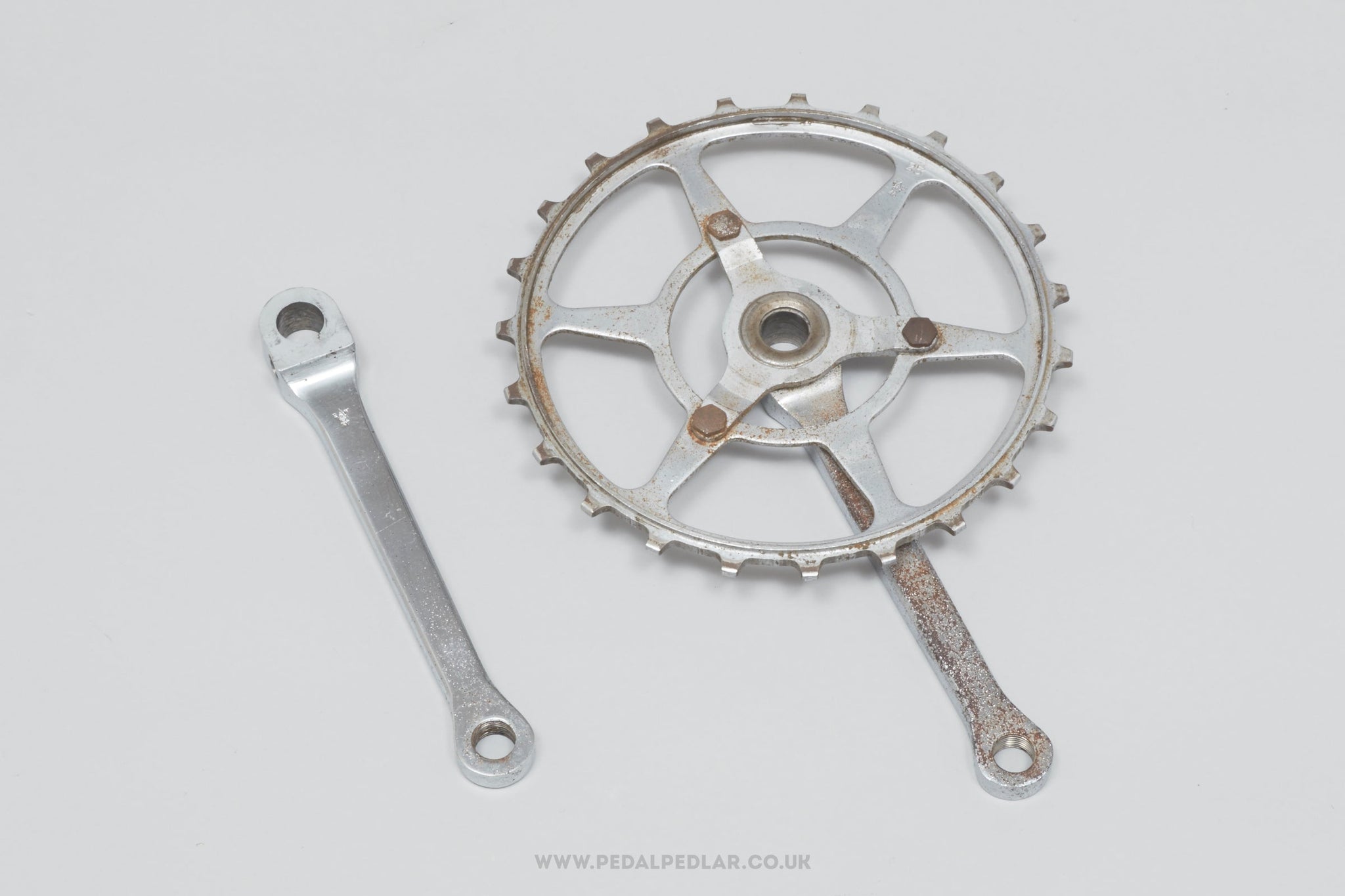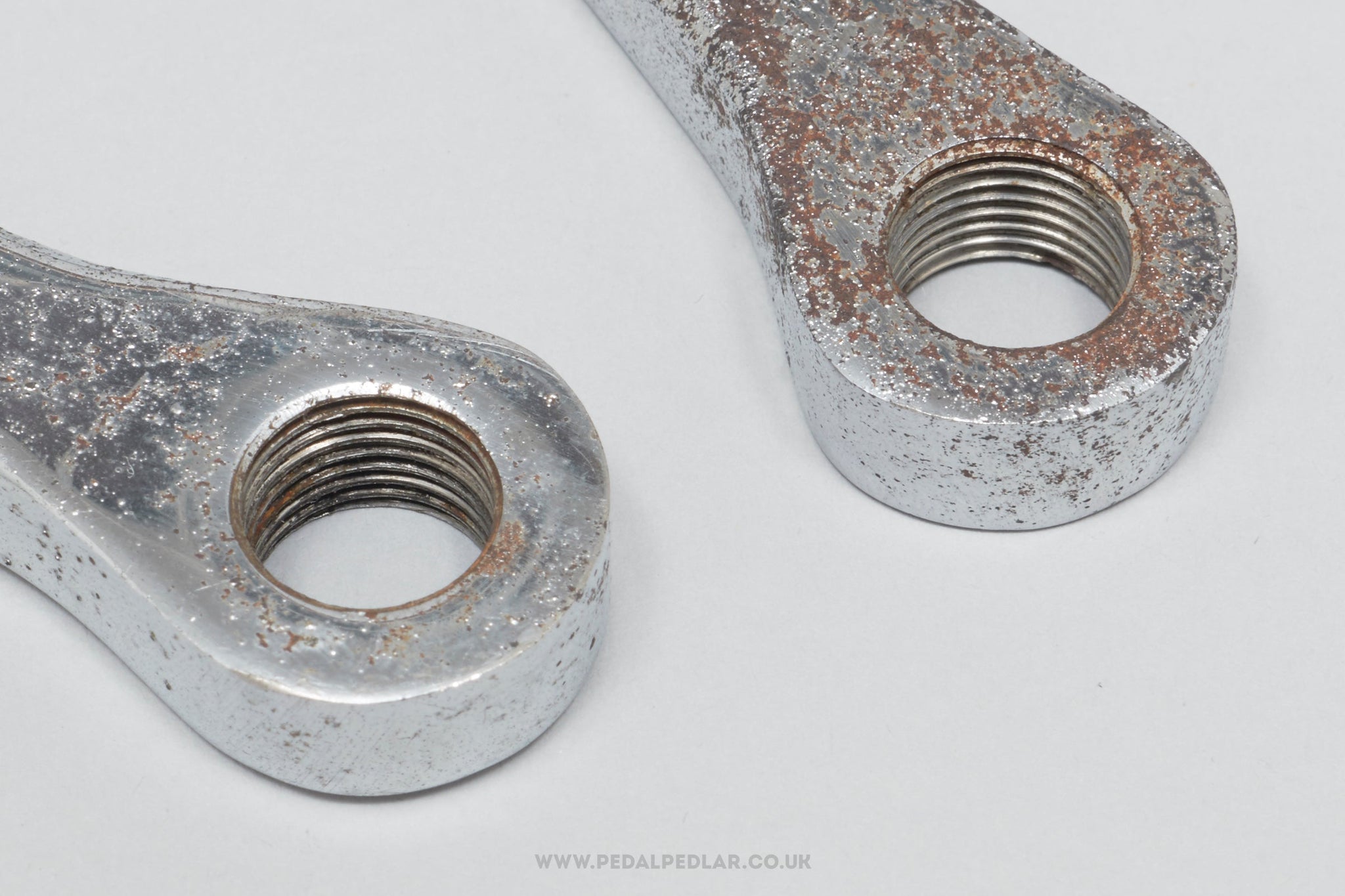- Frames
- Wheels
-
Parts
- Drivetrain & Gearing
- Downtube Shifters
- Bar Shifters
- Shift/Brake Levers
- Front Derailleurs
- Rear Derailleurs
- Chainsets
- Crank Arms
- Crank Parts
- Bottom Brackets
- Bottom Bracket Parts
- Chainrings
- Freewheels
- Cassettes
- Chains
- Gear Parts
- Braking
- Brake Sets
- Brake Calipers
- Brake Cantilevers
- Brake Levers
- Brake Parts
- Clothing
- Accessories
- Journal
Single Speed
Refine
view allProduct Type
Maillard Normandy Large Flange / Nisi Pista c.1976 Vintage 28"/700c Tubular Track/Singlespeed Rear Wheel
£70.00
✓ Original vintage wheel - produced in the 1970s
✓ Lightweight for the era - just 984 grams
✓ Professionally checked & serviced
✓ Worldwide shipping
Maillard Normandy Large Flange / Nisi Pista rear wheel, the hub hailing from France and dating back to 1976. Made from aluminium/steel and weighing in at 984 grams - pretty lightweight for a rear wheel at that time. A fine choice for keeping your vintage bike authentic, but also great for any other compatible bike too.
The wheel's been serviced, checked by one of our mechanics and graded as OK condition, but do take a good look at the detailed photos so you can see the cosmetic condition before you buy.OVERVIEW
Rim Condition - Very Good
Production Era - 1970s
Country - French
Material - Aluminium/Steel
Weight - 984 g
Stock Code - U-W-SR30V
TECHNICAL INFO
Rim Size - 28"/700c Tubular
Bike Type - Track/Singlespeed
Drilling - 36 Hole
Spacing (O.L.D.) - 116 mm
Speed - Single Speed
Sprocket Fitting - Screw On (English/ISO: 1.375 x 24 TPI)
-
▼SHIPPING, TAXES & RETURNS
-
We've been safely sending orders around the world since 2010. There's a handy shipping calculator on the shopping cart page so you can see the cost of postage as soon as you've added it to your basket. Your order will be carefully packed and sent with tracking & insurance, we despatch most orders within 2-3 days but larger items and orders placed before the weekend can take an extra day or two to process.
We accept returns, please notify us within 14 days and ensure the item arrives back with us no later than 30 days after the order was received.
We don't charge VAT, however, if buying from outside of the UK please remember that there may be import fees to pay directly to the delivery company before receiving the order. Unfortunately we can’t advise on the exact costs as it varies from country to country, so please check your national rates before purchasing.
Shimano Dura Ace NOS 13t Track Sprocket
£30.00
Generally Speaking, you only need to worry about freewheel threading if it's French. Modern (Standard ISO) & older British Or Italian freewheel threads are interchangeable in most cases. The only real exception being if you are applying extreme force (very large/strong riders or tandems)
We only sell freewheels with plenty of life left in them. We measure the stack height of each freewheel to determine if your frame has enough space for the specific freewheel.
Please refer to the detailed photographs & information below for sizings & condition.
SIZING & CONDITION
| Condition: | NOS (New Old Stock) |
| Sprocket Width: | 3/32" |
| Tooth Count: | 13t |
SHIPPING, TAXES & RETURNS
We accept returns, please notify us within 14 days and ensure the item arrives back with us no later than 30 days after the order was received.
We don't charge VAT, however, if buying from outside of the UK please remember that there may be import duties to pay upon receipt (even with the new post-Brexit trade deals, some countries may still charge you import VAT & clearance fees, so please bear this in mind when purchasing).
View full product details
Thun NOS Vintage Single 48T Cottered Town/City Crank/Chainset
£45.00
✓ Original part - in production from the 1970s to the 1980s
✓ New old stock! Still unused after all these years
✓ Suitable for historic cycling events such as L'Eroica
✓ Worldwide shipping
Thun crank/chainset, hailing from Germany and in production from the 1970s to the 1980s (yet still new & unused after all this time!). Made from steel and weighing in at 946 grams. A fine choice for keeping your vintage bike authentic, but also great for any other compatible bike too.
If you're taking part in L'Eroica or a similar vintage event, this is fully compliant - so rest assured, the pre-1987 police won't lock you up for having the wrong chainset!
0OVERVIEW
Chainring Condition - New Old Stock*
Production Era - 1970s & 1980s
Country - German
Material - Steel
Weight - 946 g
Stock Code - D-CS92V
*New old stock items may have marks from storage over the years, and as we often have multiples they can vary from piece to piece, but they are always genuine new & unused items.
TECHNICAL INFO
Chainring Count - Single
Tooth Count - 48
Bottom Bracket Type - Cottered (15.8 mm Axle Diameter)
Chain Width - 1/8"
Crank Arm Length - 170 mm
Pedal Threads - Standard (9/16" x 20 TPI)
Intended Speed* - Single Speed
Bike Type* - Town/City
*See help section.
-
▼SHIPPING, TAXES & RETURNS
-
We've been safely sending orders around the world since 2010. There's a handy shipping calculator on the shopping cart page so you can see the cost of postage as soon as you've added it to your basket. Your order will be carefully packed and sent with tracking & insurance, we despatch most orders within 2-3 days but larger items and orders placed before the weekend can take an extra day or two to process.
We accept returns, please notify us within 14 days and ensure the item arrives back with us no later than 30 days after the order was received.
We don't charge VAT, however, if buying from outside of the UK please remember that there may be import fees to pay directly to the delivery company before receiving the order. Unfortunately we can’t advise on the exact costs as it varies from country to country, so please check your national rates before purchasing.
-
▼HELP SECTION
-
Chainring Count - the number of chainrings on the chainset. Fixed gear track bikes, single-speeds and some geared bikes use a single chainring, road bikes commonly use a double (two rings) and most touring bikes and mountain bikes will use a triple chainset (three rings).
Tooth count - the number of teeth on the chainring(s), the higher the number the harder the gear.
Chain width - this is only relevant for chainsets with a single chainring - if this is ⅛” then you must use a ⅛” chain. All double and triple (and some single) ring chainsets will use a standard 3/32” chain.
BCD - stands for Bolt Circle Diameter (sometimes referred to as PCD - Pitch Circle Diameter) and is only really needed when changing chainrings. To calculate the BCD, measure the distance in millimeters from the centre of any chainring bolt to the centre of an adjacent one and multiply it by 1.709 (you’ll likely need to round the resulting number up or down a little to get your BCD measurement).
*Intended speed - the number of cogs at the back the chainset was designed to be used with. We refer to it as ‘intended’ speed as most double and triple chainsets will actually work with different speeds than originally intended, but the further away you get from the intended speed the more likely you are to experience minor setup issues. The exception being some chainsets intended for 10 speed use or higher, with these it’s better to stick to the intended speed.
Crank arm length - this is measured from the absolute centre of the bottom bracket hole to the centre of the hole for the pedal.
Pedal threads - the thread type to match that of the chainset, this must match and is usually stamped on the pedals themselves and most bikes use a standard thread of 9/16” x 20 tpi. The exceptions being older French bikes, bikes with cheaper one-piece type chainsets and Shimano’s Dyna Drive system (easily identifiable as the pedal holes are about an inch wide!).
Bottom bracket type - ‘square taper’, as the name suggests have a square shaped axle that slots into the chainset and ‘cottered’ axles are round and secured by pins - pretty much every bike up until the 1990s would use one of these, cottered being the much earlier system. Since then, different manufacturers have introduced their own systems that are not interchangeable so you must use a chainset that matches.
Unbranded NOS Vintage Single 46T Cottered Town/City Crank/Chainset
£40.00
✓ Original part - in production from the 1970s to the 1980s
✓ New old stock! Still unused after all these years
✓ Suitable for historic cycling events such as L'Eroica
✓ Worldwide shipping
Unbranded vintage crank/chainset, most likely in production from the 1970s to the 1980s (yet still new & unused after all this time!). Made from steel and weighing in at 905 grams. A fine choice for keeping your vintage bike authentic, but also great for any other compatible bike too.
If you're taking part in L'Eroica or a similar vintage event, this is fully compliant - so rest assured, the pre-1987 police won't lock you up for having the wrong chainset!
0OVERVIEW
Chainring Condition - New Old Stock*
Production Era - 1970s & 1980s
Material - Steel
Weight - 905 g
Stock Code - D-CS93V
*New old stock items may have marks from storage over the years, and as we often have multiples they can vary from piece to piece, but they are always genuine new & unused items.
TECHNICAL INFO
Chainring Count - Single
Tooth Count - 46
Bottom Bracket Type - Cottered (15.8 mm Axle Diameter)
Chain Width - 1/8"
Crank Arm Length - 170 mm
Pedal Threads - Standard (9/16" x 20 TPI)
Intended Speed* - Single Speed
Bike Type* - Town/City
*See help section.
-
▼SHIPPING, TAXES & RETURNS
-
We've been safely sending orders around the world since 2010. There's a handy shipping calculator on the shopping cart page so you can see the cost of postage as soon as you've added it to your basket. Your order will be carefully packed and sent with tracking & insurance, we despatch most orders within 2-3 days but larger items and orders placed before the weekend can take an extra day or two to process.
We accept returns, please notify us within 14 days and ensure the item arrives back with us no later than 30 days after the order was received.
We don't charge VAT, however, if buying from outside of the UK please remember that there may be import fees to pay directly to the delivery company before receiving the order. Unfortunately we can’t advise on the exact costs as it varies from country to country, so please check your national rates before purchasing.
-
▼HELP SECTION
-
Chainring Count - the number of chainrings on the chainset. Fixed gear track bikes, single-speeds and some geared bikes use a single chainring, road bikes commonly use a double (two rings) and most touring bikes and mountain bikes will use a triple chainset (three rings).
Tooth count - the number of teeth on the chainring(s), the higher the number the harder the gear.
Chain width - this is only relevant for chainsets with a single chainring - if this is ⅛” then you must use a ⅛” chain. All double and triple (and some single) ring chainsets will use a standard 3/32” chain.
BCD - stands for Bolt Circle Diameter (sometimes referred to as PCD - Pitch Circle Diameter) and is only really needed when changing chainrings. To calculate the BCD, measure the distance in millimeters from the centre of any chainring bolt to the centre of an adjacent one and multiply it by 1.709 (you’ll likely need to round the resulting number up or down a little to get your BCD measurement).
*Intended speed - the number of cogs at the back the chainset was designed to be used with. We refer to it as ‘intended’ speed as most double and triple chainsets will actually work with different speeds than originally intended, but the further away you get from the intended speed the more likely you are to experience minor setup issues. The exception being some chainsets intended for 10 speed use or higher, with these it’s better to stick to the intended speed.
Crank arm length - this is measured from the absolute centre of the bottom bracket hole to the centre of the hole for the pedal.
Pedal threads - the thread type to match that of the chainset, this must match and is usually stamped on the pedals themselves and most bikes use a standard thread of 9/16” x 20 tpi. The exceptions being older French bikes, bikes with cheaper one-piece type chainsets and Shimano’s Dyna Drive system (easily identifiable as the pedal holes are about an inch wide!).
Bottom bracket type - ‘square taper’, as the name suggests have a square shaped axle that slots into the chainset and ‘cottered’ axles are round and secured by pins - pretty much every bike up until the 1990s would use one of these, cottered being the much earlier system. Since then, different manufacturers have introduced their own systems that are not interchangeable so you must use a chainset that matches.
Unbranded NOS Vintage Single 48T Cottered Town/City Crank/Chainset
£45.00
✓ Original part - in production from the 1970s to the 1980s
✓ New old stock! Still unused after all these years
✓ Suitable for historic cycling events such as L'Eroica
✓ Worldwide shipping
Unbranded vintage crank/chainset, most likely in production from the 1970s to the 1980s (yet still new & unused after all this time!). Made from steel and weighing in at 876 grams. A fine choice for keeping your vintage bike authentic, but also great for any other compatible bike too.
If you're taking part in L'Eroica or a similar vintage event, this is fully compliant - so rest assured, the pre-1987 police won't lock you up for having the wrong chainset!
0OVERVIEW
Chainring Condition - New Old Stock*
Production Era - 1970s & 1980s
Material - Steel
Weight - 876 g
Stock Code - D-CS94V
*New old stock items may have marks from storage over the years, and as we often have multiples they can vary from piece to piece, but they are always genuine new & unused items.
TECHNICAL INFO
Chainring Count - Single
Tooth Count - 48
Bottom Bracket Type - Cottered (16 mm Axle Diameter)
Chain Width - 1/8"
Crank Arm Length - 170 mm
Pedal Threads - Standard (9/16" x 20 TPI)
Intended Speed* - Single Speed
Bike Type* - Town/City
*See help section.
-
▼SHIPPING, TAXES & RETURNS
-
We've been safely sending orders around the world since 2010. There's a handy shipping calculator on the shopping cart page so you can see the cost of postage as soon as you've added it to your basket. Your order will be carefully packed and sent with tracking & insurance, we despatch most orders within 2-3 days but larger items and orders placed before the weekend can take an extra day or two to process.
We accept returns, please notify us within 14 days and ensure the item arrives back with us no later than 30 days after the order was received.
We don't charge VAT, however, if buying from outside of the UK please remember that there may be import fees to pay directly to the delivery company before receiving the order. Unfortunately we can’t advise on the exact costs as it varies from country to country, so please check your national rates before purchasing.
-
▼HELP SECTION
-
Chainring Count - the number of chainrings on the chainset. Fixed gear track bikes, single-speeds and some geared bikes use a single chainring, road bikes commonly use a double (two rings) and most touring bikes and mountain bikes will use a triple chainset (three rings).
Tooth count - the number of teeth on the chainring(s), the higher the number the harder the gear.
Chain width - this is only relevant for chainsets with a single chainring - if this is ⅛” then you must use a ⅛” chain. All double and triple (and some single) ring chainsets will use a standard 3/32” chain.
BCD - stands for Bolt Circle Diameter (sometimes referred to as PCD - Pitch Circle Diameter) and is only really needed when changing chainrings. To calculate the BCD, measure the distance in millimeters from the centre of any chainring bolt to the centre of an adjacent one and multiply it by 1.709 (you’ll likely need to round the resulting number up or down a little to get your BCD measurement).
*Intended speed - the number of cogs at the back the chainset was designed to be used with. We refer to it as ‘intended’ speed as most double and triple chainsets will actually work with different speeds than originally intended, but the further away you get from the intended speed the more likely you are to experience minor setup issues. The exception being some chainsets intended for 10 speed use or higher, with these it’s better to stick to the intended speed.
Crank arm length - this is measured from the absolute centre of the bottom bracket hole to the centre of the hole for the pedal.
Pedal threads - the thread type to match that of the chainset, this must match and is usually stamped on the pedals themselves and most bikes use a standard thread of 9/16” x 20 tpi. The exceptions being older French bikes, bikes with cheaper one-piece type chainsets and Shimano’s Dyna Drive system (easily identifiable as the pedal holes are about an inch wide!).
Bottom bracket type - ‘square taper’, as the name suggests have a square shaped axle that slots into the chainset and ‘cottered’ axles are round and secured by pins - pretty much every bike up until the 1990s would use one of these, cottered being the much earlier system. Since then, different manufacturers have introduced their own systems that are not interchangeable so you must use a chainset that matches.
Williams C34 Inch Pitch c.1958 Vintage Single 23T Cottered Track Crank/Chainset
£115.00
✓ Original part - in production from the 1920s to the 1960s
✓ Suitable for historic cycling events such as L'Eroica
✓ Professionally checked & cleaned
✓ Worldwide shipping
Williams C34 crank/chainset, hailing from Great Britain and dating back to 1958. Made from steel and weighing in at 939 grams. A fine choice for keeping your vintage bike authentic, but also great for any other compatible bike too.
If you're taking part in L'Eroica or a similar vintage event, this is fully compliant - so rest assured, the pre-1987 police won't lock you up for having the wrong chainset!
The chainset's been carefully cleaned, thoroughly checked by one of our mechanics and graded as OK condition, but do take a good look at the detailed photos so you can see the cosmetic condition before you buy.OVERVIEW
Chainring Condition - Good
Production Era - 1920s - 1960s
Country - British
Material - Steel
Weight - 939 g
Stock Code - U-CS103V
NB - Chainring is dated 1951
TECHNICAL INFO
Chainring Count - Single
Tooth Count - 23
Bottom Bracket Type - Cottered
BCD - 88.9 BCD
Chain Width - 3/16"
Crank Arm Length - 165 mm
Pedal Threads - Standard (9/16" x 20 TPI)
Intended Speed* - Single Speed
Bike Type* - Track
*See help section.
-
▼SHIPPING, TAXES & RETURNS
-
We've been safely sending orders around the world since 2010. There's a handy shipping calculator on the shopping cart page so you can see the cost of postage as soon as you've added it to your basket. Your order will be carefully packed and sent with tracking & insurance, we despatch most orders within 2-3 days but larger items and orders placed before the weekend can take an extra day or two to process.
We accept returns, please notify us within 14 days and ensure the item arrives back with us no later than 30 days after the order was received.
We don't charge VAT, however, if buying from outside of the UK please remember that there may be import fees to pay directly to the delivery company before receiving the order. Unfortunately we can’t advise on the exact costs as it varies from country to country, so please check your national rates before purchasing.
-
▼HELP SECTION
-
Chainring Count - the number of chainrings on the chainset. Fixed gear track bikes, single-speeds and some geared bikes use a single chainring, road bikes commonly use a double (two rings) and most touring bikes and mountain bikes will use a triple chainset (three rings).
Tooth count - the number of teeth on the chainring(s), the higher the number the harder the gear.
Chain width - this is only relevant for chainsets with a single chainring - if this is ⅛” then you must use a ⅛” chain. All double and triple (and some single) ring chainsets will use a standard 3/32” chain.
BCD - stands for Bolt Circle Diameter (sometimes referred to as PCD - Pitch Circle Diameter) and is only really needed when changing chainrings. To calculate the BCD, measure the distance in millimeters from the centre of any chainring bolt to the centre of an adjacent one and multiply it by 1.709 (you’ll likely need to round the resulting number up or down a little to get your BCD measurement).
*Intended speed - the number of cogs at the back the chainset was designed to be used with. We refer to it as ‘intended’ speed as most double and triple chainsets will actually work with different speeds than originally intended, but the further away you get from the intended speed the more likely you are to experience minor setup issues. The exception being some chainsets intended for 10 speed use or higher, with these it’s better to stick to the intended speed.
Crank arm length - this is measured from the absolute centre of the bottom bracket hole to the centre of the hole for the pedal.
Pedal threads - the thread type to match that of the chainset, this must match and is usually stamped on the pedals themselves and most bikes use a standard thread of 9/16” x 20 tpi. The exceptions being older French bikes, bikes with cheaper one-piece type chainsets and Shimano’s Dyna Drive system (easily identifiable as the pedal holes are about an inch wide!).
Bottom bracket type - ‘square taper’, as the name suggests have a square shaped axle that slots into the chainset and ‘cottered’ axles are round and secured by pins - pretty much every bike up until the 1990s would use one of these, cottered being the much earlier system. Since then, different manufacturers have introduced their own systems that are not interchangeable so you must use a chainset that matches.
SUBSCRIBE TO GET THE FIRST SCOOP
Exclusive content, new products, subscriber only promotions. Delivered to your inbox by tiny cyclists, every few weeks.
Don't worry, you can unsubscribe at any time.
PEDAL PEDLAR
T: 02036758003 // E: info@pedalpedlar.co.uk
© 2025 Pedal Pedlar.
Ecommerce Software by Shopify

